I have been meditating this week upon the last line from last Sunday's gospel reading. Jesus said:
Luke 11:13
If you then, who are evil, know how to give good gifts to your children, how much more will the heavenly Father give the Holy Spirit to those who ask him!
The meaning is straightforward enough. The emphasis is on the fact that our heavenly Father is good and generous. The comparison is that even if a bad earthly Father is naturally generous to his children, how much more will a perfect heavenly Father be good and generous to his children.
And then it hits me. Did Jesus just call us good Christians "evil"? It seems a little out of place in some sense. That is, as far as I can tell he is talking to his disciples, not to some hypocritical pharisee which he has just rebuked. He talking to me. Yet I cannot deny the fittingness of the words, given the knowledge of my own sinfulness. It's just so striking when coming from the lips of the Savior. It's all so Calvinistic.
The only commentary I have found addressing it is an insightful one from my 1928 A New Commentary on the Holy Scriptures, which I picked up because Bishop Gore was one of the authors. It has this to say:
Even when Christ is appealing to the natural goodness in men, he will not let us forget our corruption. Luke's word is strong--huparchontes (being by nature) poneroi (bad or mean).
Any further thoughts from my readers? I also found it interesting that Luke 11:13 has the following cross references in my Bible:
Genesis 6:5
The LORD saw that the wickedness of man was great in the earth, and that every(B) intention of the thoughts of his heart was only evil continually.
Genesis 8:21
And when the LORD smelled the pleasing aroma, the LORD said in his heart, "I will never again curse the ground because of man, for the intention of man’s heart is evil from his youth. Neither will I ever again strike down every living creature as I have done."
Matthew 12:34
You brood of vipers! How can you speak good, when you are evil? For out of the abundance of the heart the mouth speaks.
Tuesday, July 31, 2007
Low expectations
Yesterday, I was working on a healthcare feasibility study questionnaire for the Church Pension Fund. This was sent out to everyone under the Episcopal Church's penion fund program--church employees such as musicians, secretaries, Christian education directors, chaplains, youth ministers, and of course clergy and bishops. I could not help but feel discouraged on the first page. The third question was:
3. Tell us about your healthcare coverage: (Select all that apply. For example, indicate if you are covered by both the Church and by another healthcare plan such as your spouse's/partner's plan).
Now I'm sure that the questionnaire was pretty much a standard format--the same for any corporation that needs to do this kind of study, and it was conducted by a company which specializes in these kinds of things. But these kinds of things are also necessarily tailored for the group being surveyed. Something tells me this question was not worded the same way when surveying a Baptist or Catholic or Methodist or Lutheran group, etc.
The question tells me right off the bat that in the Episcopal Church (except in isolated pockets like the diocese of Fort Worth), there is absolutely no expectation that church leaders, even the clergy who are called to be "wholesome examples to the flock," are supposed to live chaste lives.
It's not like this is any big secret, of course, but it a reminder of how discouraging it is when I'm working with couples to be married or talking with youth about the importance of chastity and not living together outside marriage, and yet the church which nurtured and ordained me has no expectation that I should strive toward same holiness in this one aspect of life.
The epistle reading for next Sunday is very fitting reminder about the vocation of Christian discipleship.
Colossians 3:2-10
Set your minds on things that are above, not on things that are on earth, for you have died, and your life is hidden with Christ in God. When Christ who is your life is revealed, then you also will be revealed with him in glory. Put to death, therefore, whatever in you is earthly: fornication, impurity, passion, evil desire, and greed (which is idolatry). On account of these the wrath of God is coming on those who are disobedient. These are the ways you also once followed, when you were living that life. But now you must get rid of all such things—anger, wrath, malice, slander, and abusive language from your mouth. Do not lie to one another, seeing that you have stripped off the old self with its practices and have clothed yourselves with the new self, which is being renewed in knowledge according to the image of its creator.
3. Tell us about your healthcare coverage: (Select all that apply. For example, indicate if you are covered by both the Church and by another healthcare plan such as your spouse's/partner's plan).
Now I'm sure that the questionnaire was pretty much a standard format--the same for any corporation that needs to do this kind of study, and it was conducted by a company which specializes in these kinds of things. But these kinds of things are also necessarily tailored for the group being surveyed. Something tells me this question was not worded the same way when surveying a Baptist or Catholic or Methodist or Lutheran group, etc.
The question tells me right off the bat that in the Episcopal Church (except in isolated pockets like the diocese of Fort Worth), there is absolutely no expectation that church leaders, even the clergy who are called to be "wholesome examples to the flock," are supposed to live chaste lives.
It's not like this is any big secret, of course, but it a reminder of how discouraging it is when I'm working with couples to be married or talking with youth about the importance of chastity and not living together outside marriage, and yet the church which nurtured and ordained me has no expectation that I should strive toward same holiness in this one aspect of life.
The epistle reading for next Sunday is very fitting reminder about the vocation of Christian discipleship.
Colossians 3:2-10
Set your minds on things that are above, not on things that are on earth, for you have died, and your life is hidden with Christ in God. When Christ who is your life is revealed, then you also will be revealed with him in glory. Put to death, therefore, whatever in you is earthly: fornication, impurity, passion, evil desire, and greed (which is idolatry). On account of these the wrath of God is coming on those who are disobedient. These are the ways you also once followed, when you were living that life. But now you must get rid of all such things—anger, wrath, malice, slander, and abusive language from your mouth. Do not lie to one another, seeing that you have stripped off the old self with its practices and have clothed yourselves with the new self, which is being renewed in knowledge according to the image of its creator.
Monday, July 30, 2007
Lord, teach us to pray.
A Christian missionary in Africa was being chased through the bush by a ravenous, hungry lion. Feeling the beast come closer with every breath, and knowing that his time was short, the man turned to the Lord in prayer. “O Lord, I pray you to make this lion a Christian.”
As soon as he prayed this prayer, the missionary instinctively knew that the lion had stopped the chase. When he turned around to look, sure enough, he saw the lion bowed down on his knees, with his hands folded, and with his lips moving in prayer. Joyous and exhilarated, the missionary wanted to join the lion in meditation. As he knelt down in front of him, the missionary heard the lion praying, “. . . and bless, O Lord this food which you have set before me . . .”
Prayer is fundamental to being Christian disciples. We are called to be God’s people, to enter into a relationship with him, and no relationship is sustained without conversation. Imagine, if you will, that someone close to you--a spouse, parent, or child--someone you see every day, never said "Good morning," never spoke to you, never said “I love you,” never told you what they thought of you, never told you what was on their mind. And yet, some expect to have a healthy relationship with God even if they never answer him.
They never answer in worship--either public or private. They never answer by speaking to the Lord (except maybe when the lions are after them). And I use the word “answer” deliberately in regards to prayer. God always takes the initiative--even when we haven’t realized it. The Bible says, “We love him because he first loved us” (1 Jn 4:19).
The catechism in the Prayer Book answers the question “What is prayer?” by saying that prayer is response--“responding to God by thoughts and by deeds, with or without words.” It puts the old question “do you think God answers prayer?” in perspective. Many people think of prayer as being like room service. We call in and place an order that God is supposed to fill.
But those who are experienced in the art of prayer have a different question in mind. “Have I been answering God in prayer?” is what they are asking. C.S. Lewis said, “I don’t pray because it changes God, I pray because God changes me. I pray because I can’t help myself. I pray because the need flows out of me.”
Do you have a prayer life like that? It is possible. It’s a relationship with God characterized by good communication. Jesus knew the art of prayer, and his disciples saw that. The Twelve were with him all hours of the day--they saw the real Jesus.
They saw things in Jesus like how he would get up extra early in the morning just to go off to a quiet place and spend some time in prayer before the distractions of the day got the best of him. The disciples asked Jesus, “Can you tell us the secret? John the Baptist taught his followers how to pray. Teach us to pray.”
It is here that Jesus teaches the disciples what has been called “the Our Father,” or “the Lord’s Prayer.” I’m sure most of you are familiar with the text, so I won’t go through it line by line. But I would like to highlight a few things that have helped me, because if you’re like me, prayer is not something that comes naturally. (Perhaps it is more natural when the lions are chasing you.) But most of the time, it is something that you need to be very deliberate and intentional about.
Prayer is an art that needs habitual formation. It is no mistake that our worship in the Catholic tradition from Sunday to Sunday and indeed from day to day is very repetitious. We need that constant formation, that regularity that shapes our own interior conversation with God.
1. I’d like to point out first, Jesus’ use of the term Father. And this is a very intimate term--Abba--it means something like “Daddy.” Jesus says when you pray, say “Father in heaven . . .” We need to be constantly reminded that God the Father Almighty, creator of heaven and earth, is big enough to fill the universe, yet small enough to dwell in the human heart.
Through Jesus--the only Son of God--we have received this personal access. God is not some distant thing, God is some one--he is our Father. We have been adopted into God’s family, and we have a right to come sit in his lap and call him daddy. Through Jesus, we have been given that privileged, personal access. And we should use it. When we begin to think of prayer in terms of family and conversation and relationship, it breaks down some of the barriers that we have to prayer. It can help prayer become more natural--even “second nature.”
2. I’d like to point out second, that Jesus’ example immediately turns to praise and adoration. When you pray, say, “Father in heaven, hallowed by thy name.” “May you be loved; may you be known everywhere as holy.” If you have not learned to praise, you have not leaned to pray. Does God answer our prayers? Absolutely he answers them. We know that because he is holy; he is wonderful, he is beautiful, he is lovely, he is kind, he is awesome, he is majestic, he is powerful, he is the fount of all goodness, he is the defender of the lowly, he is the source of all purity, he is the savior of the world, he is the abode of justice and mercy, he is the seat of all virtue, he is the giver of peace, he is the fairest of ten thousand, he is a worker of miracles, he is worthy of all praise.
What should occupy the highest calling of every parish church is the worship of almighty God. If we are not here for that reason, we are here for no reason at all. Adoration is the highest act of man--something done for God alone. As the catechism in the prayer book tells us, “Adoration is the lifting up of the heart and mind to God, asking nothing but to enjoy God’s presence.”
If you want to know what prayer is, you need to begin by practicing praise and adoration. Set aside time in the morning to praise. Set aside time in the evening simply to sit in silence and love the Lord. If there is something noble and rewarding that you regularly do, say, “I’m doing this for the Lord, to show God I love him.” Prayer can sanctify all the precious moments of our lives when we make them offerings to God, when we say “I’m doing this as an act of love, I’m doing this because I love the Lord.” When you learn to make you life a prayer, your life will change forever.
3. I’d like to point out third, Jesus’ tells us that God is a generous and powerful giver of gifts. All good things come from above, and we should bring our needs straight to the source.
While some people mistakenly picture God as a cosmic bellhop--waiting to meet our every demand--others go to far in the other direction. They feel like they should never ask for anything from God. But Jesus says no; that’s not what God is like. A Father wants to shower gifts on his children.
One of the lapel pins I wear on my jacket is a depiction of Madonna and child in the style known as “Our Lady of Perpetual Help.” When people ask me about it, I remind them, if you don’t ask for help, you don’t get it.
In the Old Testament lesson today, we see Abraham interceding with God to spare the people of Sodom and Gomorrah. He easily whittled the number down to ten--“If there are ten righteous people in Sodom,” God says, “I will not destroy it.” The truth is that if there was one righteous person in Sodom, God would have spared the city. But no one there was asking for mercy.
This church has needs--needs that it will never see met if there are not people praying for those needs to be met. Each one of you has needs in your personal life--needs that will not be met until you bring them to the Lord. Often because the things we really need most, are the things that only God can provide. I pray that everyone in this room today may feel something of the power and generosity of God. The Lord is powerful.
How long has it been since you really felt prayed for? God offers that opportunity to us. Remember to call upon the God we know intimately as Father. Remember to lavish your love and adoration upon him. And do not be ashamed to call upon his power and goodness.
Let me leave you today with the words of the Lord Jesus, “And I say to you, Ask, and it will be given to you; seek, and you will find; knock, and it will be opened to you. For everyone who asks, receives; and he who seeks, finds; and to him who knocks, it will be opened. What father among you, if his son asks for a fish, will instead of a fish, give him a serpent? or if he asks for an egg, will give him a scorpion? If you who are evil know how to give good gifts to your children, how much more will the heavenly Father give the Holy Spirit to those who ask him!”
As soon as he prayed this prayer, the missionary instinctively knew that the lion had stopped the chase. When he turned around to look, sure enough, he saw the lion bowed down on his knees, with his hands folded, and with his lips moving in prayer. Joyous and exhilarated, the missionary wanted to join the lion in meditation. As he knelt down in front of him, the missionary heard the lion praying, “. . . and bless, O Lord this food which you have set before me . . .”
Prayer is fundamental to being Christian disciples. We are called to be God’s people, to enter into a relationship with him, and no relationship is sustained without conversation. Imagine, if you will, that someone close to you--a spouse, parent, or child--someone you see every day, never said "Good morning," never spoke to you, never said “I love you,” never told you what they thought of you, never told you what was on their mind. And yet, some expect to have a healthy relationship with God even if they never answer him.
They never answer in worship--either public or private. They never answer by speaking to the Lord (except maybe when the lions are after them). And I use the word “answer” deliberately in regards to prayer. God always takes the initiative--even when we haven’t realized it. The Bible says, “We love him because he first loved us” (1 Jn 4:19).
The catechism in the Prayer Book answers the question “What is prayer?” by saying that prayer is response--“responding to God by thoughts and by deeds, with or without words.” It puts the old question “do you think God answers prayer?” in perspective. Many people think of prayer as being like room service. We call in and place an order that God is supposed to fill.
But those who are experienced in the art of prayer have a different question in mind. “Have I been answering God in prayer?” is what they are asking. C.S. Lewis said, “I don’t pray because it changes God, I pray because God changes me. I pray because I can’t help myself. I pray because the need flows out of me.”
Do you have a prayer life like that? It is possible. It’s a relationship with God characterized by good communication. Jesus knew the art of prayer, and his disciples saw that. The Twelve were with him all hours of the day--they saw the real Jesus.
They saw things in Jesus like how he would get up extra early in the morning just to go off to a quiet place and spend some time in prayer before the distractions of the day got the best of him. The disciples asked Jesus, “Can you tell us the secret? John the Baptist taught his followers how to pray. Teach us to pray.”
It is here that Jesus teaches the disciples what has been called “the Our Father,” or “the Lord’s Prayer.” I’m sure most of you are familiar with the text, so I won’t go through it line by line. But I would like to highlight a few things that have helped me, because if you’re like me, prayer is not something that comes naturally. (Perhaps it is more natural when the lions are chasing you.) But most of the time, it is something that you need to be very deliberate and intentional about.
Prayer is an art that needs habitual formation. It is no mistake that our worship in the Catholic tradition from Sunday to Sunday and indeed from day to day is very repetitious. We need that constant formation, that regularity that shapes our own interior conversation with God.
1. I’d like to point out first, Jesus’ use of the term Father. And this is a very intimate term--Abba--it means something like “Daddy.” Jesus says when you pray, say “Father in heaven . . .” We need to be constantly reminded that God the Father Almighty, creator of heaven and earth, is big enough to fill the universe, yet small enough to dwell in the human heart.
Through Jesus--the only Son of God--we have received this personal access. God is not some distant thing, God is some one--he is our Father. We have been adopted into God’s family, and we have a right to come sit in his lap and call him daddy. Through Jesus, we have been given that privileged, personal access. And we should use it. When we begin to think of prayer in terms of family and conversation and relationship, it breaks down some of the barriers that we have to prayer. It can help prayer become more natural--even “second nature.”
2. I’d like to point out second, that Jesus’ example immediately turns to praise and adoration. When you pray, say, “Father in heaven, hallowed by thy name.” “May you be loved; may you be known everywhere as holy.” If you have not learned to praise, you have not leaned to pray. Does God answer our prayers? Absolutely he answers them. We know that because he is holy; he is wonderful, he is beautiful, he is lovely, he is kind, he is awesome, he is majestic, he is powerful, he is the fount of all goodness, he is the defender of the lowly, he is the source of all purity, he is the savior of the world, he is the abode of justice and mercy, he is the seat of all virtue, he is the giver of peace, he is the fairest of ten thousand, he is a worker of miracles, he is worthy of all praise.
What should occupy the highest calling of every parish church is the worship of almighty God. If we are not here for that reason, we are here for no reason at all. Adoration is the highest act of man--something done for God alone. As the catechism in the prayer book tells us, “Adoration is the lifting up of the heart and mind to God, asking nothing but to enjoy God’s presence.”
If you want to know what prayer is, you need to begin by practicing praise and adoration. Set aside time in the morning to praise. Set aside time in the evening simply to sit in silence and love the Lord. If there is something noble and rewarding that you regularly do, say, “I’m doing this for the Lord, to show God I love him.” Prayer can sanctify all the precious moments of our lives when we make them offerings to God, when we say “I’m doing this as an act of love, I’m doing this because I love the Lord.” When you learn to make you life a prayer, your life will change forever.
3. I’d like to point out third, Jesus’ tells us that God is a generous and powerful giver of gifts. All good things come from above, and we should bring our needs straight to the source.
While some people mistakenly picture God as a cosmic bellhop--waiting to meet our every demand--others go to far in the other direction. They feel like they should never ask for anything from God. But Jesus says no; that’s not what God is like. A Father wants to shower gifts on his children.
One of the lapel pins I wear on my jacket is a depiction of Madonna and child in the style known as “Our Lady of Perpetual Help.” When people ask me about it, I remind them, if you don’t ask for help, you don’t get it.
In the Old Testament lesson today, we see Abraham interceding with God to spare the people of Sodom and Gomorrah. He easily whittled the number down to ten--“If there are ten righteous people in Sodom,” God says, “I will not destroy it.” The truth is that if there was one righteous person in Sodom, God would have spared the city. But no one there was asking for mercy.
This church has needs--needs that it will never see met if there are not people praying for those needs to be met. Each one of you has needs in your personal life--needs that will not be met until you bring them to the Lord. Often because the things we really need most, are the things that only God can provide. I pray that everyone in this room today may feel something of the power and generosity of God. The Lord is powerful.
How long has it been since you really felt prayed for? God offers that opportunity to us. Remember to call upon the God we know intimately as Father. Remember to lavish your love and adoration upon him. And do not be ashamed to call upon his power and goodness.
Let me leave you today with the words of the Lord Jesus, “And I say to you, Ask, and it will be given to you; seek, and you will find; knock, and it will be opened to you. For everyone who asks, receives; and he who seeks, finds; and to him who knocks, it will be opened. What father among you, if his son asks for a fish, will instead of a fish, give him a serpent? or if he asks for an egg, will give him a scorpion? If you who are evil know how to give good gifts to your children, how much more will the heavenly Father give the Holy Spirit to those who ask him!”
Saturday, July 28, 2007
The forgotten third English province
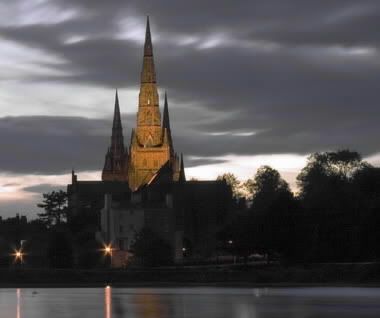
I was reading through Bishop Moorman's A History of the Church in England the other day and ran across this little historical detail which I had forgotten--the short-lived third ecclesiastical province of the church of England, the province of Lichfield. Here is the excerpt from his book:
In the second half of the eighth century it was the turn of Mercia to reach such a position [of prominence over the other kingdoms on the island]. Under the wise and powerful rule of King Offa (757-96), Mercia rose to such power that its king claimed to be 'king of all the English' though such a claim would, no doubt, have been challenged in many parts of the country. Offa was undoubtedly much the greatest ruler of his generation in England. A man of big ideas, he was one of the few English rulers who had a definite foreign connection, corresponding both with the pope and with Charlemagne. He was also a great benefactor to the Church and the founder of many monasteries.
Yet his policy with regard to the Church was mistaken. At a time when the Church was the only real unifying force in the country, Offa conceived a plan for separating Mercia from the rest of the province of Canterbury and giving it its own archbishop. Such a desire sprang from patriotism and zeal for his own kingdom; but it was disastrous for the Church. It meant that, at the moment when the Church of the southern province was beginning to act strongly and unitedly in the cause of reform, it was to be split into two. Offa, however, was determined to carry out his project and invited the pope to send to England two legates with power to carry through such a division of the province.
The two legates, George, Cardinal-Bishop of Ostia, and Theophylact, Cardinal-Bishop of Todi, arrived in England in 786, the first of a long series of papal legates who were later to play an important part in the history of England. They made a visitation not only of the southern but also of the northern province and held councils at 'Pincahala' (probably Finchale near Durham) and at Celchyth or Chelsea, both in 787. At both these councils decrees were passed, similar to those promulgated by other reforming councils, and in the same year they succeeded in carrying out the primary purpose of their visit which was to give authority for the division of the southern province into two. Offa thus achieved his ambition; Lichfield became a metropolitan see with its own archbishop and six other dioceses under its jurisdiction—Worcester, Hereford, Leicester, Sherbome, Elmham and Dunwich—leaving only Rochester, London, Winchester and Selsey to the Archbishop of Canterbury. This arrangement lasted until a few years after the death of Offa, but was brought to an end in 803.
Friday, July 27, 2007
A history of the Diocese of Fort Worth
I have put all five segments of my history paper on the diocese into one front-to-back post, below. When we consider our future, I think it's important to consider our past. Have a look.
Thursday, July 26, 2007
Forward in Mission: Parts 1-5
Forward in Mission to Equip the Saints for the Work of Ministry: A History of the Episcopal Diocese of Fort Worth
1. The Episcopal Mission in Texas
Episcopalians have had a presence in Texas since it was under the rule of Mexico, although they were not legally permitted to openly practice their faith at that time. During the Texas revolution in 1835, the Rev’d Richard Salmon led a missionary settlement from New York state, and established schools at Brazoria and Houston. Along with a fellow Anglican missionary priest named Chester Newell, Salmon applied to the Domestic and Foreign Missionary Society of the Episcopal Church for appointments as foreign missionaries, but they were denied. It was not until 1839 that the first Episcopal church was organized in Texas; the Rev’d Caleb Smith Ives established Christ Church at Matagorda. That same year, services were held in Houston, Galveston, Valesco, and Quintana. And Christ Church, Houston was also organized as a parish. (1)
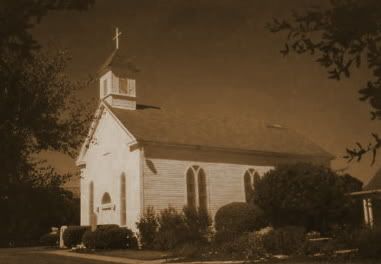
Above, Christ Church in Metagorda. Below, Bishop Leonidas Polk.
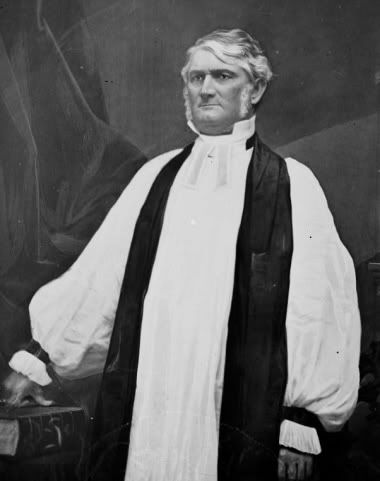
Bishop Leonidas Polk had oversight of these churches as Missionary Bishop of the Southwest. After visiting Texas in 1839, he recommended establishing a bishopric in Texas as soon as possible, especially since Bishop Polk himself had relatives who had migrated there from Tennessee and North Carolina. His venture across the Red River into northern Texas was called by Bishop Kinsolving the “first foreign missionary visit” of an Episcopal bishop, because Texas was at that time an independent Republic, and would remain so until 1845. (2)
At the General Convention of 1844, George Washington Freeman was elected as Missionary Bishop of the Southwest, with provisional oversight of the Church in the Republic of Texas. Texas was annexed to the United States in 1846, and the organization of the Diocese of Texas soon followed in Matagorda in 1849. In 1859, Alexander Gregg was elected the first Bishop of Texas. Growth was so extensive in the church there that the diocese petitioned General Convention for division in 1871. Three years later, Northern and Western Texas became two missionary districts—separated from the Episcopal Diocese of Texas in the Southeast. (3)
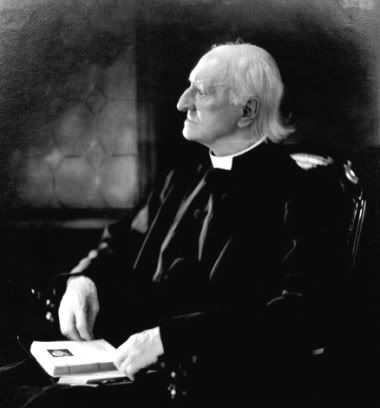
Above, The Right Rev'd Alexander Charles Garrett.
Alexander Charles Garrett, Dean of Trinity Cathedral in Omaha, was elected as the first bishop of missionary district of Northern Texas. A High Churchman of eloquence, learning, and passion, Garrett quickly set about building and planting churches in his mission field. He designated St. Matthew’s in Dallas as his cathedral and missionary outpost, and by 1895, the district had grown strong enough to become a diocese. The newly formed Diocese of Dallas remained such until 1910, when the Western portion was separated from Dallas as the remaining missionary district of Northern Texas. Garrett, the “Apostle to Northern Texas,” succeeded Daniel Tuttle as Presiding Bishop in 1923. His strong leadership, catholic faith, and missionary zeal left a lasting impression on the Episcopal Church around Dallas. (4)
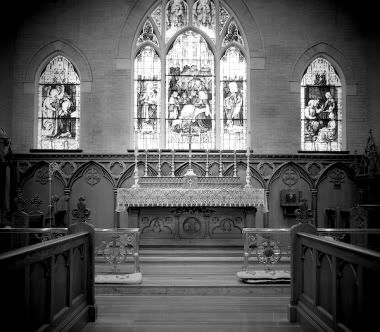
Above, the high altar of St. Matthew's Cathedral in Dallas.
The Dean of St. Matthew’s Cathedral in Dallas, Harry Tunis Moore, was elected coadjutor in 1917, and succeeded Garrett as diocesan in 1924. For Bishop Moore, the diocese existed to create and build strong parishes. (5) His successor, Charles Avery Mason, also worked tirelessly to move missions to parish status and to support parish expansion and construction projects. As Executive Secretary of the Forward in Service Movement, and then as Bishop of Dallas from 1946—1970, Mason’s zeal at his work was exercised at the risk of his own health.
Archibald Donald Davies, the fourth Bishop of Dallas, was, like Garrett, Dean of Trinity Cathedral in Omaha. And also like the first Bishop of Dallas, Davies had a heart for mission. But Davies coupled that concern with a stress on renewal and a strategy for the future. It is this bishop who brings forth the churches in Fort Worth to carry on this heritage with an innovative and evangelistic spirit in a rapidly changing ecclesiastical climate. The story of the young Episcopal Diocese of Fort Worth is one of being a missionary church in an era of conflict.
2. Catholic and Apostolic: Carving out a new Diocese
By 1982, the Diocese of Dallas had grown to encompass 115 parishes and missions, 244 resident clergy, and 39,000 communicants. These numbers were slightly down from the beginning of Bishop Davies’ ministry in Dallas in 1970. (6) However, it was thought that division of the diocese was an inevitable move whose time had come because of numerical growth and geographical concerns. A decade’s worth of long-range planning for mission, first investigated by Bishop C. Avery Mason, saw that the numerical growth in the two metropolitan centers necessitated some kind of change for the future of ministry in North Central Texas. Even with one suffragan, episcopal visitations could not be made yearly to every congregation as the situation stood in 1982.
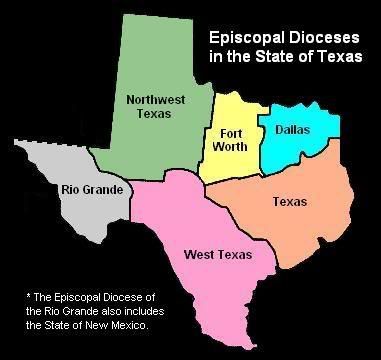
The territory of the new diocese of Fort Worth is highlighted in gold.
The Diocese of Texas, in comparison, decided to remain a large unit by having a second suffragan and help from assistant bishops. It is now the second largest diocese in the Episcopal Church. The case of Dallas was different geographically. The polarization of the twin cities of Dallas and Fort Worth provided mirror images of a diocese with rural missions supported by a large metropolitan see. It provided a nice even division, and the resulting jurisdictions were also more akin to the catholic model of a diocese, which is smaller in geographical size and oriented around a see city.
The division of 1 January 1983 was probably inevitable from the beginning, and it was the leadership of Bishop Davies that took advantage of this call to adventure in mission. As Bishop Garrett noted in the 1910 diocesan journal,
"The twin cities of Dallas and Fort Worth are growing like young giants. The little towns are stretching out their steel fingers with emerald rings strung all along to bind each other together in bonds of common life and hope of enterprise. They call upon me every day for enlarged facilities for doing their work." (7)
As separate jurisdictions, the two churches would be closer to the people, and be better able to equip them for mission in local congregations and beyond.
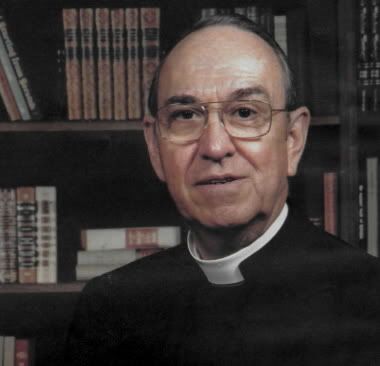
The Rev'd Canon James P. DeWolfe, Jr., of All Saints', Fort Worth.
The transition was smoothly achieved within six months of the decision by the diocesan convention—due in part to extensive planning and Bishop Davies’ leadership. Canon James DeWolfe, rector of All Saints’ Church in Forth Worth, noted, “The time was simply right. The homework was done, the need was clear, and General Convention was just around the corner.” (8) As part of his commitment toward a sound transition, Bishop Davies decided to accept the call to become the first bishop of the new (and the financially and numerically weaker) Diocese of Forth Worth.

The Rt Rev'd A. Donald Davies, first Bishop of Fort Worth.
Close working relations with the congregations and lay involvement were two of the founding principles of the Diocese of Fort Worth. In drawing up the constitution of the new diocese, emphasis was put on the participation of the deaneries—represented by the dean and one elected layperson on the Executive Council. This difference in the Fort Worth diocesan constitution was created to foster Bishop Davies’ goals of ensuring greater lay participation in decision making and prompting creative and cooperative adventures in ministry. (9)
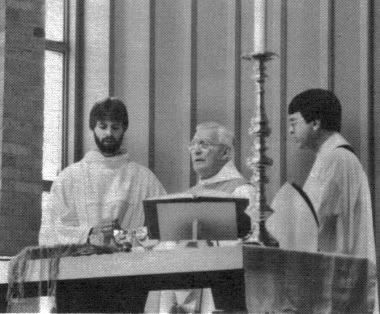
The Chrism Mass of the new diocese, held at St Christopher's.
Controversy was also a part of the birth of a separate Diocese of Fort Worth. Though, this aspect has probably been over-stressed in the past. By separating from Dallas, it is argued, the new diocese (like the Evangelical and Catholic Mission) could establish an orthodox safe-haven that would be for conservatives a “place to stand” within the Episcopal Church.
However, the deep division among the clergy, and to a lesser extent the laity, reflected at Bishop Iker’s election in 1992 indicated that this concept was more a perception than a reality. Likewise, Dallas was not necessarily carved out as a contrasting place of liberal experimentation as is sometimes thought. According to a survey by the search committee to elect a new bishop for Dallas in 1983, most of the laity in the diocese wanted their new bishop to take negative stands on the ordination of women, charismatic renewal, and homosexual ministries. (10)
In reality, for the Episcopal Church in Fort Worth, ministry and fidelity to the Church’s tradition have always gone together. The Church does not retain its teaching for itself, but for others. Therefore, as Bishop Garrett noted, the missionary idea “is the fundamental idea of an Apostolic Church.” (11) This thought resonated at the first diocesan convention of Fort Worth in October of 1983, when progress in missionary efforts was already being made.
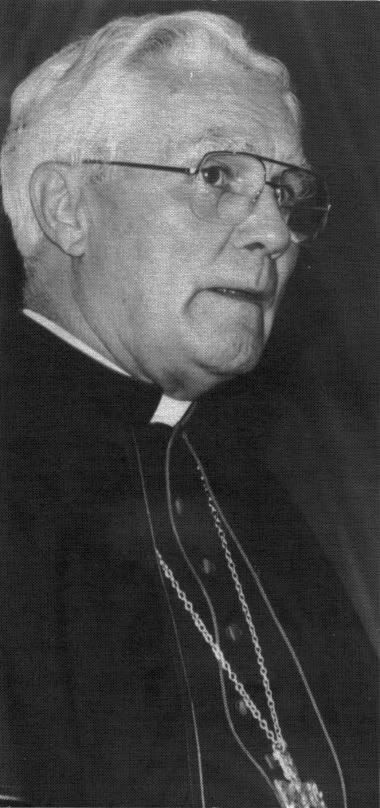
Bishop Davies of Fort Worth concluded his opening address by saying, “We are about to make a transition in Episcopal leadership in one of the most alive and exciting dioceses in the Anglican Communion.” As a part of this renewed missionary endeavor, Davies stated, “The Diocese of Fort Worth is here to stay as a witness to our Lord Jesus Christ and as a visible part of the One Holy Catholic and Apostolic Church.” (12)
3. Pope and the Partisanship
One of the reasons that the Diocese of Dallas was divided in 1982 was that Bishop Davies had announced that he would retire in 1985, and Davies did not want to leave the difficult task to his successor. Therefore, at the first diocesan convention in Fort Worth, Davies (now Bishop of Fort Worth) called for a coadjutor to be elected in 1984 to lead the new newly created diocese upon his retirement. Their choice was The Rev’d Clarence C. Pope, Jr., rector of St. Luke’s Episcopal Church in Baton Rouge, Louisiana. Bishop Davies did not end up retiring from active church ministry, however. At the request of Presiding Bishop John Allin, Davies went on to serve as bishop for the Convocation of American Churches in Europe from 1985-1988. (13)
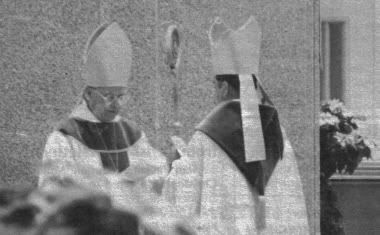
Bishop Davies hands the crozier to Bishop Pope after his consecration.
As the second Bishop of Fort Worth, Clarence Pope inherited Davies’ initiatives on renewal and mission. But what was to prove even more significant was that Pope inherited a position of leadership among the bishops of the Evangelical and Catholic Mission (ECM). Davies was also a member of the group, founded in 1976 by bishops Stanley Atkins and Charles Gaskell as a fellowship of conservative Episcopalians (particularly Anglo-Catholics) who decided to remain as an orthodox witness in the Episcopal Church following the first ordinations of women to the priesthood in Philadelphia in 1974. Other concerned churchmen, meeting in St. Louis in 1976, had decided to break with the national Church and establish churches that would continuing to maintain exclusive use of the 1928 Prayer Book and a male priesthood.
Bishop Clarence Pope took his role of leadership at home and on the national scene seriously. The chief areas of conflict for ECM within the national church were the ordination of women to the priesthood (authorized by General Convention in 1976) and the struggle to maintain biblical morality in teaching and practice. The struggle intensified with the election of Edmond Browning as Presiding Bishop in 1986, who, unlike previous the Presiding Bishop John Allin, enthusiastically supported the ordination of women as well as gay rights issues. With his strong will, eloquent voice, and depth of experience, Pope met these challenges head-on.
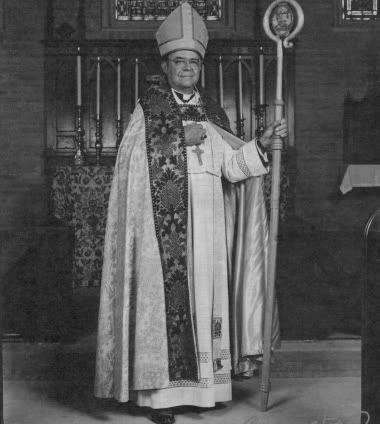
The Rt Rev'd Clarence C. Pope, Jr., II Bishop of Fort Worth.
The ordination of women quickly became the norm in most dioceses of the Episcopal Church. However, it was the election of the first female bishop (Barbara Harris as suffragan of Massachusetts) in 1988 that prompted action by the ECM. It was decided to convene a synod of the ECM clergy and people in Fort Worth on June 1-3, 1989. “The final crisis of the Episcopal Church is now upon us,” wrote the ECM bishops in a pastoral letter. They explained: "The purpose of this Synod will be to consider how we shall be the Church within the Episcopal Church and to adopt a detailed and unified plan for active witness in the face of the institution’s present disintegration." (14)
The meeting of the ECM in 1989 in Fort Worth begot a new organization to succeed it—the Episcopal Synod of America—with Bishop Pope as its first president. The election of a female diocesan seemed inevitable with the consecration of Bishop Harris, and did occur in 1993 when the Diocese of Vermont elected Archdeacon Mary Adelia McLeod of West Virginia as their diocesan bishop. The Synod dealt with the question of episcopal ministry for parishes that may not accept female bishops. In light of the episcopal visitor’s clause created by the 1988 General Convention, the ESA resolved to provide the ministry of alternative episcopal visitors where requested. (15)

Women Anglican bishops gathered at the 1998 Lambeth Conference.
This was, however, a provisional action. The advent of female diocesan bishops was approaching, and the movement toward the ordination of women was gaining momentum in England. While Pope was publicly trying to plug the leaks in the Episcopal Church, privately he was seeking a long-term solution. For Pope, the most promising solution lay beyond the Alps. “I was thrilled to the possibility for our communion [with Rome],” said Bishop Pope, “as the Anglican— Roman Catholic International Commission took up their work and made such wonderful progress in finding a way forward toward organic reunion between Rome and Canterbury.” (16)
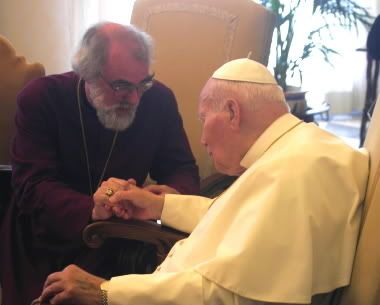
The official dialogue between the Pope and the Archbishop of Canterbury.
With the Roman and Anglican Communions going in opposite directions on the question of women’s ordination, that hope was steadily diminishing. But perhaps it still would be possible on a smaller scale. Was there a place for whole Anglican dioceses and associated parishes to find a home in the Roman Catholic Church? Bernard Cardinal Law of Boston, head of the Anglican Use congregations under the “Pastoral Provision” of 1980, was lobbying for an extension of the program in the United States.
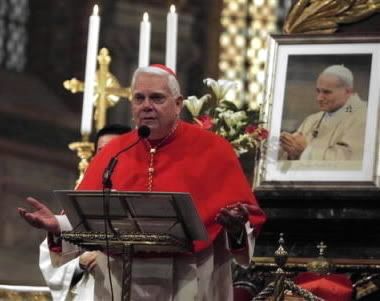
Bernard Cardinal Law, former Archbishop of Boston.
With the help of Cardinal Law, Bishop Pope attempted to negotiate at most a kind of personal prelature (modeled on Opus Dei) or perhaps an expanded pastoral provision similar to a uniat province (with their own liturgy and bishops, under Canon 372, §2) with the Holy See. Cardinal Hume of Westminster was also lobbying for a similar arrangement in England. Josef Cardinal Ratzinger, Prefect for the Congregation of the Doctrine of the Faith in Rome, was very supportive. In 1990, Bishop Clarence Pope met with Pope John Paul II, who embraced the Anglican bishop and gestured toward him, saying “in communion.” (17)
Prospects could not have appeared better, yet when Bishop Pope returned to Texas, nothing happened. Action on the plan had been stalled by Roman Catholic bishops in England. They did not want to receive a large faction of English Catholics opposed to the ordination of women and loyal to the pope. They produced a counter-proposal stating that Anglicans could convert as groups, but would then be absorbed into mainstream parish life. They could not maintain an Anglican identity as several parishes in the US had done under the pastoral provision.
This development essentially took away the Roman option for English Anglo-Catholics. With the succession of George Carey in the see of Canterbury 1991 and the approval of female priests in England in 1992, there were some conversions to Rome, but on a smaller scale and only as individuals. Back in America, what was once a communion-wide possibility and eventually only a diocesan possibility, was now merely a personal possibility. Many traditional Anglicans felt that the dawn of female priests in England left them no choice. In 1991, the parish of St. Mary the Virgin in Arlington voted to leave the Episcopal Diocese of Fort Worth for communion with Rome. On the other side of Fort Worth, the Church of the Holy Apostles decided that they could no longer remain in the Episcopal Church either. They changed their affiliation to the Antiochian Orthodox Church in 1992.

Bishop Pope, in ailing health and despondent over the long wait for a corporate reunion with Rome which was never to come, announced on 25 October 1994 that he would convert to Roman Catholicism upon his retirement at the end of the year. Bishop Pope cited the 1992 act of synod to ordain women as priests in the Church of England as the final impetus in his decision. “It was then,” said Pope, “that I became very aware that the pilgrimage I had longed to take corporately would now have to be taken alone.” While most of the leaders in the diocese sympathized with the bishop, others left behind in the Episcopal Church felt abandoned. His fellow ESA bishop, William Sheridan, remarked, “It’s a terrible self-centeredness.” (18)
Clarence Pope and his wife Martha were received into the Roman Catholic Church by Cardinal Law in a special ceremony at the former Episcopal parish of St. Mary the Virgin in Arlington. However, Pope’s plight was not over. The Popes retired to their former home of Baton Rouge in Louisiana. Clarence Pope presented himself to the local bishop for priestly ordination under the terms of the pastoral provision. Pope felt that a continuation of his ministry would allow him to serve out his calling in a new home. The Catholic bishop of Baton Rouge announced that he would be happy to ordain Pope as a priest . . . pending the approval of his diocesan priests’ council (which finally returned a negative vote).

Pope was isolated from the Catholic community in Baton Rouge and he started getting calls from his successor in Fort Worth, Bishop Jack Iker, and from Episcopal Presiding Bishop Edmond Browning to withdraw his resignation from the House of Bishops and return to the Anglican fold. Less than a year after their conversion, the Popes returned to the Episcopal Church. Pope confessed that he tended to idealize the Roman Catholic Church and found the reality somewhat different. He also noted increasing discomfort with the idea of absolute (re)ordination and a sense of guilt that he had abandoned traditionalists in the Episcopal Church. (19)
4. A Difficult Transition
Bishop Pope’s leadership—which tended to be perceived as equating national leadership in the ESA with leadership back in the Diocese of Fort Worth—was not without opposition at home. Some contested Pope’s conservative views; others agreed with them, but did not want to be drawn into a political struggle. All Saints’ Cathedral in Fort Worth (a generally conservative parish) was seen as being used to promote Pope’s agenda with which most parishioners agreed. However, the dean, the Very Rev’d William D. Nix, Jr. and members of the Vestry complained about being tied to the ESA’s national political struggle. A period of conflict between All Saints’ and the diocesan office led to the parish choosing to end its status as the pro-cathedral of the new diocese.
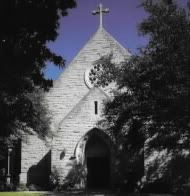
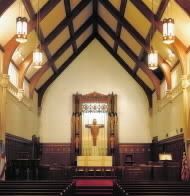
All Saints' Cathedral in Fort Worth.
Others were hoping to move the Diocese of Fort Worth more in line with the policies of the national church. In order to obtain episcopal assistance and forestall the possible election of a liberal successor, Pope called for the election of a coadjutor in 1992 without announcing his retirement. The ordination of women was a contentious issue throughout the election process. The nomination committee put forth four candidates—Fr. Jack Iker of the Church of the Redeemer in Sarasota, Florida; Fr. Keith Ackerman of St. Mark’s in Arlington, Texas; Dean Richard Hatfield of Christ Cathedral in Salina, Kansas; and Fr. Dwight Duncan of St. Matthias in Dallas. All four candidates indicated that they would neither ordain women as priests, nor license them to minister in the diocese.
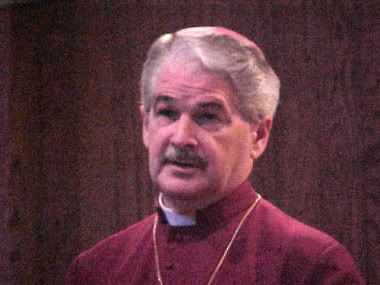
The Rt Rev'd Jack Leo Iker, III Bishop of Fort Worth.
A group of liberal opposition called the Council of Laity nominated Fr. John Payne of All Saints’ Church in Wichita Falls, Texas from the floor of the convention, held in October of 1992. Although originally a member of the ESA, Payne had grown to favor the ordination of women. The Rev’d Jack Iker won decisively on the sixth ballot, but the opposition party refused to join the customary unanimous resolution vote out of protest over his opposition to the ordination of women. (20)
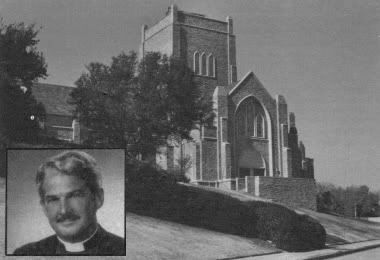
St Stephen's Presbyterian Church in Fort Worth, the site of the consecration.
The Council of Laity continued their protest by a campaign to thwart the process of consent from other diocesan standing committees and bishops. Within a short time of the election, a significant number of refusals came in from standing committees across the Episcopal Church. Bishop Pope called Iker at the time and advised him to not resign from his parish nor come to look for a house in Fort Worth just yet. A very slim margin of standing committee consents was finally obtained on 26 January 1993, after a push by Bishops Benitez, Bowman, and Kelshaw who insisted that the Church honor its commitments to tolerance on the women’s ordination issue. (21) Iker was finally consecrated as a bishop on 24 April 1993 at St. Stephen’s Presbyterian Church in Fort Worth amid picketers outside, and six formal protests inside. (22)
5. A Renewed Focus on Mission
Upon the retirement of Clarence Pope in 1995, Jack Leo Iker became the third Bishop of Fort Worth. Bishop Iker’s pontificate has been marked by growing unity and revitalization on the diocesan level. Since his election, Iker has explicitly attempted to build bridges with both those who supported and opposed him. “I recognize and respect your position and rightful place in the church,” he told convention delegates. “I make the commitment to love you and work with you wherever you happen to be on the theological spectrum. I simply ask you to do the same.” While he has remained active in the ESA (now Forward in Faith, North America), Iker has not taken on leadership of the organization as did Bishop Pope.
Bishop Iker has also been vocal about his commitment to stay in the Episcopal Church. One of his first actions was to designate St. Vincent’s Church in Bedford—a young, vibrant congregation—as the pro-Cathedral for the duration of his episcopate. Like Bishop Terwilliger, the late suffragan of Dallas, Iker has decided not to confront the Episcopal Church by threatening to leave, but by threatening to stay.
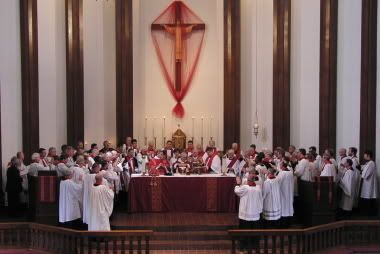
The Chrism Mass at St Vincent's Cathedral in Bedford, TX.
As coadjuctor, Bishop Iker presided over the last diocesan convention (October 1994) before Bishop Pope’s retirement. The executive director of the ESA, Fr. Samuel Edwards, proposed resolutions that would have repealed Article 1 of the diocesan constitution, and enabled parishes to secede with their property, and would have removed from parishes the option of sending money to the national church. “We need to begin disengaging from a morally corrupt national organizational structure,” said Fr. Edwards. Edwards argued that the action would not exactly be leaving the Episcopal Church, but only disengaging from it’s national control.
But Bishop Iker countered from the chair that passage of the resolution would in fact mean the diocese would be seceding from the Episcopal Church, and urged others to vote against the resolutions. Although national issues may be troubling, Iker noted, leaving is not the way to address the problem. The resolutions were rejected.
Similarly, when Bishop Pope announced his decision to leave the Episcopal Church, Bishop Iker quickly put out a pastoral letter in which he expressed sympathy with Pope’s concerns, but also stated: "It should be stressed that this is a personal decision of Bishop Pope’s and indicates no change of direction for the Diocese of Fort Worth. This is a time for us all to pull closer together as a diocese and to move forward with the work God has given us to do with gladness and singleness of heart. I still believe we have an important role to play within the Episcopal Church, and by God’s grace, I intend to lead us in this vocation with courage and enthusiasm."
Despite conflict with the national church, or perhaps because of it (with a growing sense of the irrelevance of national church policies), the Diocese of Fort Worth has steered away from separatist political considerations and focused more on renewal and mission at home. One of Bishop Iker’s stated goals for the diocese was a plan for emphasis upon evangelism and spiritual renewal.
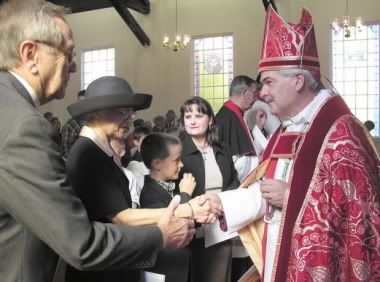
This led to his first Conference on Evangelism and Renewal, held at the downtown parish of St. Andrew’s in April of 1995. The conference was called a spiritual pep rally by the bishop. It also provided important workshops for clergy and lay leaders on learning to joyfully and effectively share the gospel within and beyond their congregations. “We must be anointed by God and empowered by the Spirit to go forth and share the good news with others,” said Iker. But, he added that we must also “first be convinced ourselves that it is good news, and that it is worth sharing.”
In a further attempt to build bridges and meet needs at home in the diocese, Bishop Iker developed “The Dallas Plan” together with Bishop James Stanton of Dallas. This informal pastoral arrangement was developed to meet the needs of potential female ordinands as well as congregations on both sides of the issue of women’s ordination. The agreement supplies workable provisions for both the ordination and priestly ministry of women. At present, no congregation has called a female assistant priest or rector, but several women have been ordained to the priesthood through the Dallas Plan.
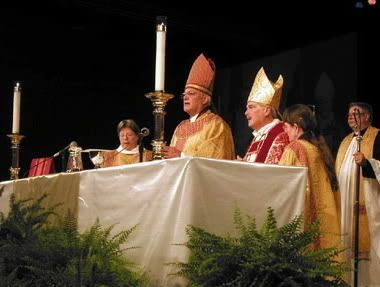
Bishop Iker at the Altar with Dallas Bishop James M. Stanton.
In spite of this agreement, the 1997 General Convention voted to amend the canons to make the ordination of women mandatory in all dioceses of the Episcopal Church. “The tragic thing,” noted Iker, “is that they are seeking to require something that the Scriptures do not require.” It was also the Anglican principle of not requiring things not found in holy Scripture which led to a diocesan constitutional amendment, qualifying the moral teaching authority of General Convention.
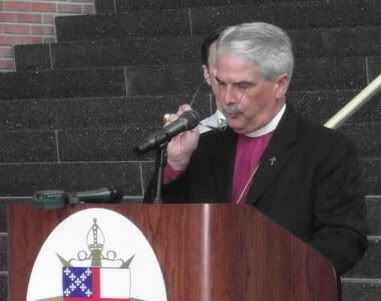
Because of the impending approval of same-sex blessings by the national church, the 1997 diocesan convention of Fort Worth changed the wording of the diocesan constitution to indicate that it recognizes the authority of the national Constitution and Canons and the General Convention, “provided that no action of General Convention which is contrary to Holy Scripture and the Apostolic Teaching of the Church shall be of any force or effect” in the Episcopal Diocese of Fort Worth.
Although the constitutional change does not weaken the tension with the national church, it does allow the diocese to remain in the Episcopal Church while in good conscience remaining loyal to Anglican tradition. The Bishop also cautioned against reading too much into the change. “I want to say again that I am not leading a secret movement out of the Episcopal Church,” Iker stated to the delegates. “I am working to carve out a place to stand. I will do whatever it takes to defend this diocese from revisionism, heresy, and factionalism.”
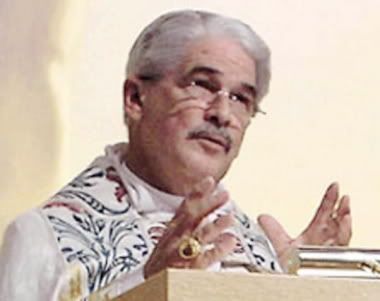
Indeed, Bishop Iker has called Fort Worth anew to its purpose since the beginning of the Church crossed into Texas—being a missionary Church. Following the bishop’s request in September 2001, the Executive Council adopted as the mission statement for Fort Worth: “To equip the Saints for the work of ministry” (Eph 4:12). At the 2001 Diocesan Convention, Iker noted: "The central theme that I have turned to year after year in these convention addresses has been the same for the past nine years—mission. I have called us to become a truly missionary diocese, focused upon evangelism, outreach, and church growth."
The future of the church in Fort Worth lies in carrying on its heritage—the apostolic work of ministry, rooted in the catholic faith.
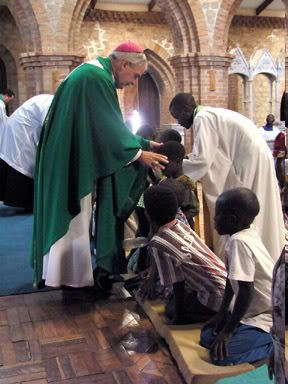
Bishop Iker on a mission trip in the companion Diocese of Northern Malawi.
Notes
1. Lawrence L. Brown, “Protestant Episcopal Church,” in the Online Texas Handbook.
2. Clause A. Beesley, The Episcopal Church in Northern Texas (Wichita Falls: privately printed, 1952), 13, 10.
3. Ibid., 20, 32.
4. C. Preston Wiles, The Episcopal Diocese of Dallas: A Centennial Narrative History (Dallas: privately printed, 1995), 9-25.
5. Ibid., 26.
6. Ibid., 46.
7. Quoted in The Living Church 185, no. 24 (12 December 1982): 7.
8. Ibid.
9. Ibid.
10. Reported in an article by Helen Parmley in the Dallas Morning News, cited in The Christian Challenge XXII, no. 5 (May 1983): 18.
11. Alexander C. Garrett, The Church: Its Mission and Principals of Growth (Hartford: Wiley, Waterman, & Eaton, 1876.), 25.
12. A. Donald Davies, “The Bishop’s Address to the First Annual Convention of the Episcopal Diocese of Forth Worth,” (sermon of the opening Eucharist of the Convention at Trinity Episcopal Church, Forth Worth, TX) 8 October 1983.
13. The Living Church 191, no. 25 (22 December 1985): 7.
14. A. Donald Davies, ed., The Episcopal Synod of America: Speeches, Sermons, Documents and Pictures from the Founding Meeting (Harrisburg, PA: Morehouse, 1990), 107-110.
15. David L. Holmes, A Brief History of the Episcopal Church (Harrisburg, PA: Trinity, 1993), 169-70; and Davies, ed., Ibid., 121-122.
16. The Living Church 209, no. 20 (13 November 1994): 6.
17. For a detailed narrative of the negotiations for union with Rome, see: William Oddie, The Roman Option: Crisis and the Realignment of English-speaking Christianity. New York: HarperCollins, 1997. Available used.
18. The Living Church 209, no. 20 (13 November 1994): 6.
19. The Living Church 211, no. 11 (10 September 1995): 19.
20. The Living Church 205, no. 17 (25 October 1992): 6.
21. The Christian Challenge XXXII, no. 2 (March 1993): 16-17.
22. The Living Church 206, no. 20 (16 May 1993): 6.
23. The Living Church 205, no. 17 (25 October 1992): 6.
24. The Living Church 209, no. 18 (30 October 1994): 6.
25. The Living Church 209, no. 20 (13 November 1994): 6.
26. The Living Church 210, no. 25 (18 June 1995): 6.
27. As Bishop Iker explained, “Any woman in this Diocese who wishes to enter into the ordination process for the priesthood must first secure the endorsement of her parish priest and then arrange for an interview of the two of them with me. I then recommend her to Bishop Stanton so that she may enter into the discernment process in Dallas. If any congregation here insists on going against my wishes and must have a woman priest at their church, I am willing to relinquish my episcopal oversight of that congregation to Bishop Stanton, so that he may license and institute a woman priest there. The congregation would remain fully a part of this Diocese; the woman priest would be fully a part of the Diocese of Dallas, while serving under this special pastoral provision. The desire to continue to live and work together, in spite of differences on this issue, means that this is a good and workable plan for this Diocese” (from the Forward in Mission, a publication of the Episcopal Diocese of Fort Worth, September 1997).
28. Jack L. Iker, “Conservatively Speaking.” Interview by Jim DeLa (Advent 2000). The Southern Cross, a publication of the Diocese of Southwest Florida; c.f., Article VI of the Articles of Religion, in The Book of Common Prayer, 868.
29. The Living Church 215, no. 23 (7 December 1997): 6.
30. Ibid., 8.
31. Jack L. Iker, “The Bishop’s Address to the Nineteenth Annual Convention of the Episcopal Diocese of Forth Worth,” (sermon of the opening Eucharist of the Convention at the Church of the Holy Apostles, Forth Worth, TX) 9 November 2001.
1. The Episcopal Mission in Texas
Episcopalians have had a presence in Texas since it was under the rule of Mexico, although they were not legally permitted to openly practice their faith at that time. During the Texas revolution in 1835, the Rev’d Richard Salmon led a missionary settlement from New York state, and established schools at Brazoria and Houston. Along with a fellow Anglican missionary priest named Chester Newell, Salmon applied to the Domestic and Foreign Missionary Society of the Episcopal Church for appointments as foreign missionaries, but they were denied. It was not until 1839 that the first Episcopal church was organized in Texas; the Rev’d Caleb Smith Ives established Christ Church at Matagorda. That same year, services were held in Houston, Galveston, Valesco, and Quintana. And Christ Church, Houston was also organized as a parish. (1)

Above, Christ Church in Metagorda. Below, Bishop Leonidas Polk.

Bishop Leonidas Polk had oversight of these churches as Missionary Bishop of the Southwest. After visiting Texas in 1839, he recommended establishing a bishopric in Texas as soon as possible, especially since Bishop Polk himself had relatives who had migrated there from Tennessee and North Carolina. His venture across the Red River into northern Texas was called by Bishop Kinsolving the “first foreign missionary visit” of an Episcopal bishop, because Texas was at that time an independent Republic, and would remain so until 1845. (2)
At the General Convention of 1844, George Washington Freeman was elected as Missionary Bishop of the Southwest, with provisional oversight of the Church in the Republic of Texas. Texas was annexed to the United States in 1846, and the organization of the Diocese of Texas soon followed in Matagorda in 1849. In 1859, Alexander Gregg was elected the first Bishop of Texas. Growth was so extensive in the church there that the diocese petitioned General Convention for division in 1871. Three years later, Northern and Western Texas became two missionary districts—separated from the Episcopal Diocese of Texas in the Southeast. (3)

Above, The Right Rev'd Alexander Charles Garrett.
Alexander Charles Garrett, Dean of Trinity Cathedral in Omaha, was elected as the first bishop of missionary district of Northern Texas. A High Churchman of eloquence, learning, and passion, Garrett quickly set about building and planting churches in his mission field. He designated St. Matthew’s in Dallas as his cathedral and missionary outpost, and by 1895, the district had grown strong enough to become a diocese. The newly formed Diocese of Dallas remained such until 1910, when the Western portion was separated from Dallas as the remaining missionary district of Northern Texas. Garrett, the “Apostle to Northern Texas,” succeeded Daniel Tuttle as Presiding Bishop in 1923. His strong leadership, catholic faith, and missionary zeal left a lasting impression on the Episcopal Church around Dallas. (4)

Above, the high altar of St. Matthew's Cathedral in Dallas.
The Dean of St. Matthew’s Cathedral in Dallas, Harry Tunis Moore, was elected coadjutor in 1917, and succeeded Garrett as diocesan in 1924. For Bishop Moore, the diocese existed to create and build strong parishes. (5) His successor, Charles Avery Mason, also worked tirelessly to move missions to parish status and to support parish expansion and construction projects. As Executive Secretary of the Forward in Service Movement, and then as Bishop of Dallas from 1946—1970, Mason’s zeal at his work was exercised at the risk of his own health.
Archibald Donald Davies, the fourth Bishop of Dallas, was, like Garrett, Dean of Trinity Cathedral in Omaha. And also like the first Bishop of Dallas, Davies had a heart for mission. But Davies coupled that concern with a stress on renewal and a strategy for the future. It is this bishop who brings forth the churches in Fort Worth to carry on this heritage with an innovative and evangelistic spirit in a rapidly changing ecclesiastical climate. The story of the young Episcopal Diocese of Fort Worth is one of being a missionary church in an era of conflict.
2. Catholic and Apostolic: Carving out a new Diocese
By 1982, the Diocese of Dallas had grown to encompass 115 parishes and missions, 244 resident clergy, and 39,000 communicants. These numbers were slightly down from the beginning of Bishop Davies’ ministry in Dallas in 1970. (6) However, it was thought that division of the diocese was an inevitable move whose time had come because of numerical growth and geographical concerns. A decade’s worth of long-range planning for mission, first investigated by Bishop C. Avery Mason, saw that the numerical growth in the two metropolitan centers necessitated some kind of change for the future of ministry in North Central Texas. Even with one suffragan, episcopal visitations could not be made yearly to every congregation as the situation stood in 1982.

The territory of the new diocese of Fort Worth is highlighted in gold.
The Diocese of Texas, in comparison, decided to remain a large unit by having a second suffragan and help from assistant bishops. It is now the second largest diocese in the Episcopal Church. The case of Dallas was different geographically. The polarization of the twin cities of Dallas and Fort Worth provided mirror images of a diocese with rural missions supported by a large metropolitan see. It provided a nice even division, and the resulting jurisdictions were also more akin to the catholic model of a diocese, which is smaller in geographical size and oriented around a see city.
The division of 1 January 1983 was probably inevitable from the beginning, and it was the leadership of Bishop Davies that took advantage of this call to adventure in mission. As Bishop Garrett noted in the 1910 diocesan journal,
"The twin cities of Dallas and Fort Worth are growing like young giants. The little towns are stretching out their steel fingers with emerald rings strung all along to bind each other together in bonds of common life and hope of enterprise. They call upon me every day for enlarged facilities for doing their work." (7)
As separate jurisdictions, the two churches would be closer to the people, and be better able to equip them for mission in local congregations and beyond.

The Rev'd Canon James P. DeWolfe, Jr., of All Saints', Fort Worth.
The transition was smoothly achieved within six months of the decision by the diocesan convention—due in part to extensive planning and Bishop Davies’ leadership. Canon James DeWolfe, rector of All Saints’ Church in Forth Worth, noted, “The time was simply right. The homework was done, the need was clear, and General Convention was just around the corner.” (8) As part of his commitment toward a sound transition, Bishop Davies decided to accept the call to become the first bishop of the new (and the financially and numerically weaker) Diocese of Forth Worth.

The Rt Rev'd A. Donald Davies, first Bishop of Fort Worth.
Close working relations with the congregations and lay involvement were two of the founding principles of the Diocese of Fort Worth. In drawing up the constitution of the new diocese, emphasis was put on the participation of the deaneries—represented by the dean and one elected layperson on the Executive Council. This difference in the Fort Worth diocesan constitution was created to foster Bishop Davies’ goals of ensuring greater lay participation in decision making and prompting creative and cooperative adventures in ministry. (9)

The Chrism Mass of the new diocese, held at St Christopher's.
Controversy was also a part of the birth of a separate Diocese of Fort Worth. Though, this aspect has probably been over-stressed in the past. By separating from Dallas, it is argued, the new diocese (like the Evangelical and Catholic Mission) could establish an orthodox safe-haven that would be for conservatives a “place to stand” within the Episcopal Church.
However, the deep division among the clergy, and to a lesser extent the laity, reflected at Bishop Iker’s election in 1992 indicated that this concept was more a perception than a reality. Likewise, Dallas was not necessarily carved out as a contrasting place of liberal experimentation as is sometimes thought. According to a survey by the search committee to elect a new bishop for Dallas in 1983, most of the laity in the diocese wanted their new bishop to take negative stands on the ordination of women, charismatic renewal, and homosexual ministries. (10)
In reality, for the Episcopal Church in Fort Worth, ministry and fidelity to the Church’s tradition have always gone together. The Church does not retain its teaching for itself, but for others. Therefore, as Bishop Garrett noted, the missionary idea “is the fundamental idea of an Apostolic Church.” (11) This thought resonated at the first diocesan convention of Fort Worth in October of 1983, when progress in missionary efforts was already being made.

Bishop Davies of Fort Worth concluded his opening address by saying, “We are about to make a transition in Episcopal leadership in one of the most alive and exciting dioceses in the Anglican Communion.” As a part of this renewed missionary endeavor, Davies stated, “The Diocese of Fort Worth is here to stay as a witness to our Lord Jesus Christ and as a visible part of the One Holy Catholic and Apostolic Church.” (12)
3. Pope and the Partisanship
One of the reasons that the Diocese of Dallas was divided in 1982 was that Bishop Davies had announced that he would retire in 1985, and Davies did not want to leave the difficult task to his successor. Therefore, at the first diocesan convention in Fort Worth, Davies (now Bishop of Fort Worth) called for a coadjutor to be elected in 1984 to lead the new newly created diocese upon his retirement. Their choice was The Rev’d Clarence C. Pope, Jr., rector of St. Luke’s Episcopal Church in Baton Rouge, Louisiana. Bishop Davies did not end up retiring from active church ministry, however. At the request of Presiding Bishop John Allin, Davies went on to serve as bishop for the Convocation of American Churches in Europe from 1985-1988. (13)

Bishop Davies hands the crozier to Bishop Pope after his consecration.
As the second Bishop of Fort Worth, Clarence Pope inherited Davies’ initiatives on renewal and mission. But what was to prove even more significant was that Pope inherited a position of leadership among the bishops of the Evangelical and Catholic Mission (ECM). Davies was also a member of the group, founded in 1976 by bishops Stanley Atkins and Charles Gaskell as a fellowship of conservative Episcopalians (particularly Anglo-Catholics) who decided to remain as an orthodox witness in the Episcopal Church following the first ordinations of women to the priesthood in Philadelphia in 1974. Other concerned churchmen, meeting in St. Louis in 1976, had decided to break with the national Church and establish churches that would continuing to maintain exclusive use of the 1928 Prayer Book and a male priesthood.
Bishop Clarence Pope took his role of leadership at home and on the national scene seriously. The chief areas of conflict for ECM within the national church were the ordination of women to the priesthood (authorized by General Convention in 1976) and the struggle to maintain biblical morality in teaching and practice. The struggle intensified with the election of Edmond Browning as Presiding Bishop in 1986, who, unlike previous the Presiding Bishop John Allin, enthusiastically supported the ordination of women as well as gay rights issues. With his strong will, eloquent voice, and depth of experience, Pope met these challenges head-on.

The Rt Rev'd Clarence C. Pope, Jr., II Bishop of Fort Worth.
The ordination of women quickly became the norm in most dioceses of the Episcopal Church. However, it was the election of the first female bishop (Barbara Harris as suffragan of Massachusetts) in 1988 that prompted action by the ECM. It was decided to convene a synod of the ECM clergy and people in Fort Worth on June 1-3, 1989. “The final crisis of the Episcopal Church is now upon us,” wrote the ECM bishops in a pastoral letter. They explained: "The purpose of this Synod will be to consider how we shall be the Church within the Episcopal Church and to adopt a detailed and unified plan for active witness in the face of the institution’s present disintegration." (14)
The meeting of the ECM in 1989 in Fort Worth begot a new organization to succeed it—the Episcopal Synod of America—with Bishop Pope as its first president. The election of a female diocesan seemed inevitable with the consecration of Bishop Harris, and did occur in 1993 when the Diocese of Vermont elected Archdeacon Mary Adelia McLeod of West Virginia as their diocesan bishop. The Synod dealt with the question of episcopal ministry for parishes that may not accept female bishops. In light of the episcopal visitor’s clause created by the 1988 General Convention, the ESA resolved to provide the ministry of alternative episcopal visitors where requested. (15)

Women Anglican bishops gathered at the 1998 Lambeth Conference.
This was, however, a provisional action. The advent of female diocesan bishops was approaching, and the movement toward the ordination of women was gaining momentum in England. While Pope was publicly trying to plug the leaks in the Episcopal Church, privately he was seeking a long-term solution. For Pope, the most promising solution lay beyond the Alps. “I was thrilled to the possibility for our communion [with Rome],” said Bishop Pope, “as the Anglican— Roman Catholic International Commission took up their work and made such wonderful progress in finding a way forward toward organic reunion between Rome and Canterbury.” (16)

The official dialogue between the Pope and the Archbishop of Canterbury.
With the Roman and Anglican Communions going in opposite directions on the question of women’s ordination, that hope was steadily diminishing. But perhaps it still would be possible on a smaller scale. Was there a place for whole Anglican dioceses and associated parishes to find a home in the Roman Catholic Church? Bernard Cardinal Law of Boston, head of the Anglican Use congregations under the “Pastoral Provision” of 1980, was lobbying for an extension of the program in the United States.

Bernard Cardinal Law, former Archbishop of Boston.
With the help of Cardinal Law, Bishop Pope attempted to negotiate at most a kind of personal prelature (modeled on Opus Dei) or perhaps an expanded pastoral provision similar to a uniat province (with their own liturgy and bishops, under Canon 372, §2) with the Holy See. Cardinal Hume of Westminster was also lobbying for a similar arrangement in England. Josef Cardinal Ratzinger, Prefect for the Congregation of the Doctrine of the Faith in Rome, was very supportive. In 1990, Bishop Clarence Pope met with Pope John Paul II, who embraced the Anglican bishop and gestured toward him, saying “in communion.” (17)
Prospects could not have appeared better, yet when Bishop Pope returned to Texas, nothing happened. Action on the plan had been stalled by Roman Catholic bishops in England. They did not want to receive a large faction of English Catholics opposed to the ordination of women and loyal to the pope. They produced a counter-proposal stating that Anglicans could convert as groups, but would then be absorbed into mainstream parish life. They could not maintain an Anglican identity as several parishes in the US had done under the pastoral provision.
This development essentially took away the Roman option for English Anglo-Catholics. With the succession of George Carey in the see of Canterbury 1991 and the approval of female priests in England in 1992, there were some conversions to Rome, but on a smaller scale and only as individuals. Back in America, what was once a communion-wide possibility and eventually only a diocesan possibility, was now merely a personal possibility. Many traditional Anglicans felt that the dawn of female priests in England left them no choice. In 1991, the parish of St. Mary the Virgin in Arlington voted to leave the Episcopal Diocese of Fort Worth for communion with Rome. On the other side of Fort Worth, the Church of the Holy Apostles decided that they could no longer remain in the Episcopal Church either. They changed their affiliation to the Antiochian Orthodox Church in 1992.

Bishop Pope, in ailing health and despondent over the long wait for a corporate reunion with Rome which was never to come, announced on 25 October 1994 that he would convert to Roman Catholicism upon his retirement at the end of the year. Bishop Pope cited the 1992 act of synod to ordain women as priests in the Church of England as the final impetus in his decision. “It was then,” said Pope, “that I became very aware that the pilgrimage I had longed to take corporately would now have to be taken alone.” While most of the leaders in the diocese sympathized with the bishop, others left behind in the Episcopal Church felt abandoned. His fellow ESA bishop, William Sheridan, remarked, “It’s a terrible self-centeredness.” (18)
Clarence Pope and his wife Martha were received into the Roman Catholic Church by Cardinal Law in a special ceremony at the former Episcopal parish of St. Mary the Virgin in Arlington. However, Pope’s plight was not over. The Popes retired to their former home of Baton Rouge in Louisiana. Clarence Pope presented himself to the local bishop for priestly ordination under the terms of the pastoral provision. Pope felt that a continuation of his ministry would allow him to serve out his calling in a new home. The Catholic bishop of Baton Rouge announced that he would be happy to ordain Pope as a priest . . . pending the approval of his diocesan priests’ council (which finally returned a negative vote).

Pope was isolated from the Catholic community in Baton Rouge and he started getting calls from his successor in Fort Worth, Bishop Jack Iker, and from Episcopal Presiding Bishop Edmond Browning to withdraw his resignation from the House of Bishops and return to the Anglican fold. Less than a year after their conversion, the Popes returned to the Episcopal Church. Pope confessed that he tended to idealize the Roman Catholic Church and found the reality somewhat different. He also noted increasing discomfort with the idea of absolute (re)ordination and a sense of guilt that he had abandoned traditionalists in the Episcopal Church. (19)
4. A Difficult Transition
Bishop Pope’s leadership—which tended to be perceived as equating national leadership in the ESA with leadership back in the Diocese of Fort Worth—was not without opposition at home. Some contested Pope’s conservative views; others agreed with them, but did not want to be drawn into a political struggle. All Saints’ Cathedral in Fort Worth (a generally conservative parish) was seen as being used to promote Pope’s agenda with which most parishioners agreed. However, the dean, the Very Rev’d William D. Nix, Jr. and members of the Vestry complained about being tied to the ESA’s national political struggle. A period of conflict between All Saints’ and the diocesan office led to the parish choosing to end its status as the pro-cathedral of the new diocese.


All Saints' Cathedral in Fort Worth.
Others were hoping to move the Diocese of Fort Worth more in line with the policies of the national church. In order to obtain episcopal assistance and forestall the possible election of a liberal successor, Pope called for the election of a coadjutor in 1992 without announcing his retirement. The ordination of women was a contentious issue throughout the election process. The nomination committee put forth four candidates—Fr. Jack Iker of the Church of the Redeemer in Sarasota, Florida; Fr. Keith Ackerman of St. Mark’s in Arlington, Texas; Dean Richard Hatfield of Christ Cathedral in Salina, Kansas; and Fr. Dwight Duncan of St. Matthias in Dallas. All four candidates indicated that they would neither ordain women as priests, nor license them to minister in the diocese.

The Rt Rev'd Jack Leo Iker, III Bishop of Fort Worth.
A group of liberal opposition called the Council of Laity nominated Fr. John Payne of All Saints’ Church in Wichita Falls, Texas from the floor of the convention, held in October of 1992. Although originally a member of the ESA, Payne had grown to favor the ordination of women. The Rev’d Jack Iker won decisively on the sixth ballot, but the opposition party refused to join the customary unanimous resolution vote out of protest over his opposition to the ordination of women. (20)

St Stephen's Presbyterian Church in Fort Worth, the site of the consecration.
The Council of Laity continued their protest by a campaign to thwart the process of consent from other diocesan standing committees and bishops. Within a short time of the election, a significant number of refusals came in from standing committees across the Episcopal Church. Bishop Pope called Iker at the time and advised him to not resign from his parish nor come to look for a house in Fort Worth just yet. A very slim margin of standing committee consents was finally obtained on 26 January 1993, after a push by Bishops Benitez, Bowman, and Kelshaw who insisted that the Church honor its commitments to tolerance on the women’s ordination issue. (21) Iker was finally consecrated as a bishop on 24 April 1993 at St. Stephen’s Presbyterian Church in Fort Worth amid picketers outside, and six formal protests inside. (22)
5. A Renewed Focus on Mission
Upon the retirement of Clarence Pope in 1995, Jack Leo Iker became the third Bishop of Fort Worth. Bishop Iker’s pontificate has been marked by growing unity and revitalization on the diocesan level. Since his election, Iker has explicitly attempted to build bridges with both those who supported and opposed him. “I recognize and respect your position and rightful place in the church,” he told convention delegates. “I make the commitment to love you and work with you wherever you happen to be on the theological spectrum. I simply ask you to do the same.” While he has remained active in the ESA (now Forward in Faith, North America), Iker has not taken on leadership of the organization as did Bishop Pope.
Bishop Iker has also been vocal about his commitment to stay in the Episcopal Church. One of his first actions was to designate St. Vincent’s Church in Bedford—a young, vibrant congregation—as the pro-Cathedral for the duration of his episcopate. Like Bishop Terwilliger, the late suffragan of Dallas, Iker has decided not to confront the Episcopal Church by threatening to leave, but by threatening to stay.

The Chrism Mass at St Vincent's Cathedral in Bedford, TX.
As coadjuctor, Bishop Iker presided over the last diocesan convention (October 1994) before Bishop Pope’s retirement. The executive director of the ESA, Fr. Samuel Edwards, proposed resolutions that would have repealed Article 1 of the diocesan constitution, and enabled parishes to secede with their property, and would have removed from parishes the option of sending money to the national church. “We need to begin disengaging from a morally corrupt national organizational structure,” said Fr. Edwards. Edwards argued that the action would not exactly be leaving the Episcopal Church, but only disengaging from it’s national control.
But Bishop Iker countered from the chair that passage of the resolution would in fact mean the diocese would be seceding from the Episcopal Church, and urged others to vote against the resolutions. Although national issues may be troubling, Iker noted, leaving is not the way to address the problem. The resolutions were rejected.
Similarly, when Bishop Pope announced his decision to leave the Episcopal Church, Bishop Iker quickly put out a pastoral letter in which he expressed sympathy with Pope’s concerns, but also stated: "It should be stressed that this is a personal decision of Bishop Pope’s and indicates no change of direction for the Diocese of Fort Worth. This is a time for us all to pull closer together as a diocese and to move forward with the work God has given us to do with gladness and singleness of heart. I still believe we have an important role to play within the Episcopal Church, and by God’s grace, I intend to lead us in this vocation with courage and enthusiasm."
Despite conflict with the national church, or perhaps because of it (with a growing sense of the irrelevance of national church policies), the Diocese of Fort Worth has steered away from separatist political considerations and focused more on renewal and mission at home. One of Bishop Iker’s stated goals for the diocese was a plan for emphasis upon evangelism and spiritual renewal.

This led to his first Conference on Evangelism and Renewal, held at the downtown parish of St. Andrew’s in April of 1995. The conference was called a spiritual pep rally by the bishop. It also provided important workshops for clergy and lay leaders on learning to joyfully and effectively share the gospel within and beyond their congregations. “We must be anointed by God and empowered by the Spirit to go forth and share the good news with others,” said Iker. But, he added that we must also “first be convinced ourselves that it is good news, and that it is worth sharing.”
In a further attempt to build bridges and meet needs at home in the diocese, Bishop Iker developed “The Dallas Plan” together with Bishop James Stanton of Dallas. This informal pastoral arrangement was developed to meet the needs of potential female ordinands as well as congregations on both sides of the issue of women’s ordination. The agreement supplies workable provisions for both the ordination and priestly ministry of women. At present, no congregation has called a female assistant priest or rector, but several women have been ordained to the priesthood through the Dallas Plan.

Bishop Iker at the Altar with Dallas Bishop James M. Stanton.
In spite of this agreement, the 1997 General Convention voted to amend the canons to make the ordination of women mandatory in all dioceses of the Episcopal Church. “The tragic thing,” noted Iker, “is that they are seeking to require something that the Scriptures do not require.” It was also the Anglican principle of not requiring things not found in holy Scripture which led to a diocesan constitutional amendment, qualifying the moral teaching authority of General Convention.

Because of the impending approval of same-sex blessings by the national church, the 1997 diocesan convention of Fort Worth changed the wording of the diocesan constitution to indicate that it recognizes the authority of the national Constitution and Canons and the General Convention, “provided that no action of General Convention which is contrary to Holy Scripture and the Apostolic Teaching of the Church shall be of any force or effect” in the Episcopal Diocese of Fort Worth.
Although the constitutional change does not weaken the tension with the national church, it does allow the diocese to remain in the Episcopal Church while in good conscience remaining loyal to Anglican tradition. The Bishop also cautioned against reading too much into the change. “I want to say again that I am not leading a secret movement out of the Episcopal Church,” Iker stated to the delegates. “I am working to carve out a place to stand. I will do whatever it takes to defend this diocese from revisionism, heresy, and factionalism.”

Indeed, Bishop Iker has called Fort Worth anew to its purpose since the beginning of the Church crossed into Texas—being a missionary Church. Following the bishop’s request in September 2001, the Executive Council adopted as the mission statement for Fort Worth: “To equip the Saints for the work of ministry” (Eph 4:12). At the 2001 Diocesan Convention, Iker noted: "The central theme that I have turned to year after year in these convention addresses has been the same for the past nine years—mission. I have called us to become a truly missionary diocese, focused upon evangelism, outreach, and church growth."
The future of the church in Fort Worth lies in carrying on its heritage—the apostolic work of ministry, rooted in the catholic faith.

Bishop Iker on a mission trip in the companion Diocese of Northern Malawi.
Notes
1. Lawrence L. Brown, “Protestant Episcopal Church,” in the Online Texas Handbook.
2. Clause A. Beesley, The Episcopal Church in Northern Texas (Wichita Falls: privately printed, 1952), 13, 10.
3. Ibid., 20, 32.
4. C. Preston Wiles, The Episcopal Diocese of Dallas: A Centennial Narrative History (Dallas: privately printed, 1995), 9-25.
5. Ibid., 26.
6. Ibid., 46.
7. Quoted in The Living Church 185, no. 24 (12 December 1982): 7.
8. Ibid.
9. Ibid.
10. Reported in an article by Helen Parmley in the Dallas Morning News, cited in The Christian Challenge XXII, no. 5 (May 1983): 18.
11. Alexander C. Garrett, The Church: Its Mission and Principals of Growth (Hartford: Wiley, Waterman, & Eaton, 1876.), 25.
12. A. Donald Davies, “The Bishop’s Address to the First Annual Convention of the Episcopal Diocese of Forth Worth,” (sermon of the opening Eucharist of the Convention at Trinity Episcopal Church, Forth Worth, TX) 8 October 1983.
13. The Living Church 191, no. 25 (22 December 1985): 7.
14. A. Donald Davies, ed., The Episcopal Synod of America: Speeches, Sermons, Documents and Pictures from the Founding Meeting (Harrisburg, PA: Morehouse, 1990), 107-110.
15. David L. Holmes, A Brief History of the Episcopal Church (Harrisburg, PA: Trinity, 1993), 169-70; and Davies, ed., Ibid., 121-122.
16. The Living Church 209, no. 20 (13 November 1994): 6.
17. For a detailed narrative of the negotiations for union with Rome, see: William Oddie, The Roman Option: Crisis and the Realignment of English-speaking Christianity. New York: HarperCollins, 1997. Available used.
18. The Living Church 209, no. 20 (13 November 1994): 6.
19. The Living Church 211, no. 11 (10 September 1995): 19.
20. The Living Church 205, no. 17 (25 October 1992): 6.
21. The Christian Challenge XXXII, no. 2 (March 1993): 16-17.
22. The Living Church 206, no. 20 (16 May 1993): 6.
23. The Living Church 205, no. 17 (25 October 1992): 6.
24. The Living Church 209, no. 18 (30 October 1994): 6.
25. The Living Church 209, no. 20 (13 November 1994): 6.
26. The Living Church 210, no. 25 (18 June 1995): 6.
27. As Bishop Iker explained, “Any woman in this Diocese who wishes to enter into the ordination process for the priesthood must first secure the endorsement of her parish priest and then arrange for an interview of the two of them with me. I then recommend her to Bishop Stanton so that she may enter into the discernment process in Dallas. If any congregation here insists on going against my wishes and must have a woman priest at their church, I am willing to relinquish my episcopal oversight of that congregation to Bishop Stanton, so that he may license and institute a woman priest there. The congregation would remain fully a part of this Diocese; the woman priest would be fully a part of the Diocese of Dallas, while serving under this special pastoral provision. The desire to continue to live and work together, in spite of differences on this issue, means that this is a good and workable plan for this Diocese” (from the Forward in Mission, a publication of the Episcopal Diocese of Fort Worth, September 1997).
28. Jack L. Iker, “Conservatively Speaking.” Interview by Jim DeLa (Advent 2000). The Southern Cross, a publication of the Diocese of Southwest Florida; c.f., Article VI of the Articles of Religion, in The Book of Common Prayer, 868.
29. The Living Church 215, no. 23 (7 December 1997): 6.
30. Ibid., 8.
31. Jack L. Iker, “The Bishop’s Address to the Nineteenth Annual Convention of the Episcopal Diocese of Forth Worth,” (sermon of the opening Eucharist of the Convention at the Church of the Holy Apostles, Forth Worth, TX) 9 November 2001.
Friday, July 20, 2007
Self-love will change the world
From the Live Earth special televised event, while no one was watching, comes this truly dreadful song from Madonna called "Hey you!" The song from the July 7th concert tells us that the key to saving the planet is vanity. No, seriously.
Hey you!
Don't you give up; it's not so bad.
There's still a chance for us.
Hey you!
Just be yourself; don't be so shy.
There's reasons why it's hard.
The Taizé-esque refrain goes like this:
First love yourself, then you can love someone else.
If you can change someone else, then you have saved someone else.
But you must first love yourself, then you can love someone else.
If you can change someone else, then you have saved someone else.
It is true that self-love will change the world. But not for the better. In theology, it is what we call vanity or the sin of pride. I thought the following criticism of the self-esteem movement from the article on Wikipedia was particularly insightful: "Some social constructionists argue that modern day America with its overwhelming cultural bias towards self-enhancement has fabricated and validated the dogma of self-esteem as a universal human goal that all must strive towards perfecting." For further reading, consider this article from Scientific American, titled "Exploding the Self-Esteem Myth."
Thursday, July 19, 2007
The new dean is immanently qualified*
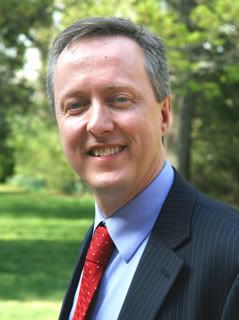
The new dean of Virginia Theological Seminary, Dr. Ian Markham, is the unanimous choice of the board of trustees to succeed lead the seminary into the future. Dr. Markham holds a Ph.D. in Christian Ethics from the University of Exeter, an M. Litt. in Philosophy and Ethics from the University of Cambridge, and a Bachelor of Divinity in Theology from the University of London.
He has been Dean of Hartford Seminary and Professor of Theology and Ethics since August of 2001. He also served as Director of the Doctor of Ministry program at Hartford Seminary from 2001 to 2005, and directed the seminary’s accreditation self-study process from 2002 to 2003. Prior to serving as Dean of Hartford Seminary he was Foundation Dean and Liverpool Professor of Theology and Public Life at Liverpool Hope University in Liverpool, England, from 1998 to 2001, where he served as a member of the senior management team and strategic planning committee; Liverpool Professor of Theology and Public Life at Liverpool Hope University from 1996 to December 1998; and Lecturer and sub Dean of the Faculty of Arts at the University of Exeter in England from 1989 to August of 1996.
There is no doubt that he is immanently qualified to be the dean of a school of theology. There is just one little problem. This is not just a school of theology, but a seminary--a school to train priests. And Dr. Markham is not a priest. But he was recently ordained a deacon, and will have been a deacon for almost three months by the time school starts. He is on tract to be ordained to the priesthood, probably before the school year is out. (Something tells me he doesn't need to study too hard for his ordination exams.)
Although I am certainly not one to downplay the importance of strong academic theological education, but we also have to remember that VTS is not about training people to give lectures and write papers. Its mission is to train ministers of the gospel, mostly future priests of the church. For that, it seems to me that experience in the priesthood (preferably at least some in the parish) is a more valuable asset for the dean of a seminary, who needs to be a pastor and mentor to the seminarians.
Wednesday, July 18, 2007
Whose church is this?

I ran across this interesting little factiod the other day. As a kind of capital of Christianity, Rome is home to several churches called "Patriarchal Basilicas" (renamed "Papal" basilicas by Benedict XVI). Each of the five ancient patriarchs of the Christian church has a basilica in Rome specifically designated for his use. It's not quite the same as being his cathedral, but more of a home away from home, like a senator or congressman would have an apartment in Washington in addition to his residence back in his or her home state or district.
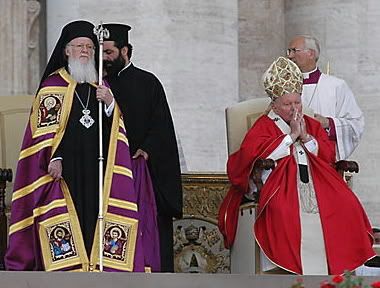
Left, Ecumenical Patriarch Bartholomew; Right, the late Pope John Paul II.
The Basilica of St Peter is assigned to the Patriarch of Constantinople. It is also known as the Vatican basilica.
The Basilica of St John Lateran is the cathedral church of the Bishop of Rome, hence it also serves as the archbasilica for the pope. It's full name is the Archbasilica of the Most Holy Saviour, St. John the Baptist and St. John the Evangelist at the Lateran. It is also called the Lateran basilica.
The Basilica of St Paul outside the Walls, technically a parish church, is assigned to the Patriarch of Alexandria. It is also known as the Ostian basilica.
The Basilica of St Mary Major is assigned to the Patriarch of Antioch. It is also called the Liberian basilica.
The Basilica of St Lawrence outside the Walls, the only one of the five without a holy door, is assigned to the Patriarch of Jerusalem.
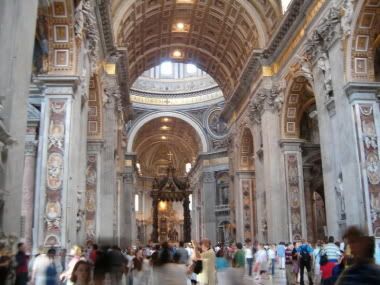
What I have not been able to figure out for sure is if these basilicas in Rome are assigned to the Latin patriarchates set up at the time of the crusades, or to the original Orthodox patriarchates. If anyone knows, please comment.
Monday, July 16, 2007
For those in "ecclesial communities"
Some Christians outside the Roman Catholic Church have expressed dismay at the recent statement from the Congregation of the Doctrine of the Faith clarifying some questions about the Catholic teaching about the nature of the church, particularly that Protestant churches are not churches in the fullest sense, and are thus instead termed "ecclesial communities." Some have asked me about it, so I thought I would make some points that might help those of us outside Rome's umbrella to understand what they mean and where they're coming from.
The meaning of "church"
I think the key distinction to understand is that when Rome uses the word “church” it is nearly always in the visible, structural sense. Even when the more recent expression of the church as the "people of God" is used, it is still in reference to a visible entity. When most Protestants use the word “church”, it is more often than not in the invisible sense (i.e., the collection of all believer, or all the elect). So when the statement talks about other churches not being churches in the true sense, it is only talking about visible institutions. It is not saying that others are not true believers or that they are not Christians, nor even that they are cut off from all the means of salvation that are a part of the church's life. Indeed, note that they statement points out:
It is possible, according to Catholic doctrine, to affirm correctly that the Church of Christ is present and operative in the churches and ecclesial Communities not yet fully in communion with the Catholic Church, on account of the elements of sanctification and truth that are present in them. . . . It follows that these separated churches and Communities, though we believe they suffer from defects, are deprived neither of significance nor importance in the mystery of salvation. In fact the Spirit of Christ has not refrained from using them as instruments of salvation, whose value derives from that fullness of grace and of truth which has been entrusted to the Catholic Church.
It is saying that other “ecclesial communities” (or church-like organizations) bear many, but not all of the essential characteristics of a church. To use the analogy of a house. It would be to call something a house-like structure, but say we can’t really call it a true “house” because it is missing some things (be it a roof, or plumbing, or doors, or people to live in it).
The document does refer to the Eastern Orthodox churches as churches in the true sense because they are considered by Rome to have all the essential elements (or, it is really a house because it has walls, a roof, plumbing, doors, people, and everything else). They have all the elements of a church, and lack nothing more than visible unity with the See of Peter and, perhaps. So they are called “sister churches”, and other groups which have most of the features of a church are called “ecclesial communities.” Of these ecclesial communities, the Second Vatican Council stated, "Among those in which some Catholic traditions and institutions continue to exist, the Anglican Communion occupies a special place."
In Rome’s view, that one defect is the invalidity of our ordinations, and thus all the sacraments that must be celebrated by a validly ordained priest. Rome’s position was not entirely clear until Pope Leo III gave his judgment on the question in his letter Apostolicae Curae in 1896, declaring Anglican orders "absolutely null and utterly void. The Pope's judgment was forcefully refuted by the Church of England in their official response Saepius Officio. Since that time the question has also been muddied by the participation of bishops in our episcopal ordinations who are validly ordained bishops, in Rome’s view. Still, that judgment stands as far as the Vatican is concerned.
The Anglican-Roman Catholic International Commission has made great progress in dialogue and agreed statements on this and many issues that need to be reconciled. Despite the ordination problem, ecumenical relations have been close since the time of Archbishop Ramsey and Pope Paul VI. The Pope repeatedly referred to the Church of England and the Anglican Communion as "our beloved sister church" and gave Ramsey the gift of his own papal ring, which the succeeding Archbishops of Canterbury have worn and cherished.
The Old Catholic Churches of the Union of Utrecht (whom Rome considers to have valid orders) accepts Anglican orders as completely valid and entered into full communion with us in 1930. That relationship was rescinded by one member church, the Polish National Catholic Church (USA) after the Episcopal Church started ordaining women. What about the Eastern Orthodox? They have a slightly different theology about ordinations and the question of validity. They would say that Anglican clergy have all the same marks of validity that Roman clergy have—except what they both lack, which is union with the Orthodox.
The Anglican position
As far as our own view? Of course we hold that our orders are valid (except that not all Anglican believe that women can be validly ordained—so that whole issue has caused great problems in our communion). We claim they are valid because of an unbroken apostolic succession. We also explicitly stated the intention to continue the same kind of ordained ministry in the preface to the ordination rites: “It has been, and is, the intention and purpose of this Church to maintain and continue these three orders” (i.e., bishop, priest, and deacon).
As for our view of the church and “ecclesial communities”. Like Rome, our use of the term “church,” at least in confessional statements and theological discourse, is mainly in the sense of the visible institutional structure. As an example, here is the description of the church from Resolution 9 of the 1920 Lambeth Conference:
I. We believe that God wills fellowship. By God's own act this fellowship was made in and through Jesus Christ, and its life is in his Spirit. We believe that it is God's purpose to manifest this fellowship, so far as the world is concerned, in an outward, visible, and united society, holding one faith, having its own recognised officers, using God-given means of grace, and inspiring all its members to the world-wide service of the Kingdom of God. This is what we mean by the Catholic Church.
Like Rome, we also take the position that there are some things that are essential for an ecclesial community to be a church in the fullest sense. Although, for charity’s sake, we don’t refrain from using the word “church” about those institutions that we think are lacking in some essential matter. Also, we stress that all who are validly baptized belong to Christ and are members of the holy Catholic Church, regardless how imperfectly that institutional realization may be. I’d say Rome takes a similar view, but does not emphasize it as much.
The clearest Anglican statement on the essentials of a “church” (in that visible sense) was made at the beginning of the ecumenical movement as a guideline for approaching other churches in dialogue. The first version was made by the House of Bishops of the Episcopal Church in 1886. It was taken and used as a resolution of the 1888 Lambeth Conference, to speak for the whole Communion on the matter. The bishops stated:
We do hereby affirm that the Christian unity can be restored only by the return of all Christian communions to the principles of unity exemplified by the undivided Catholic Church during the first ages of its existence; which principles we believe to be the substantial deposit of Christian Faith and Order committed by Christ and his Apostles to the Church unto the end of the world, and therefore incapable of compromise or surrender by those who have been ordained to be its stewards and trustees for the common and equal benefit of all men.
As inherent parts of this sacred deposit, and therefore as essential to the restoration of unity among the divided branches of Christendom, we account the following, to wit:
1. The Holy Scriptures of the Old and New Testaments as the revealed Word of God.
2. The Nicene Creed as the sufficient statement of the Christian Faith.
3. The two Sacraments,--Baptism and the Supper of the Lord,--ministered with unfailing use of Christ's words of institution and of the elements ordained by Him.
4. The Historic Episcopate, locally adapted in the methods of its administration to the varying needs of the nations and peoples called of God into the unity of His Church.
The meaning of "church"
I think the key distinction to understand is that when Rome uses the word “church” it is nearly always in the visible, structural sense. Even when the more recent expression of the church as the "people of God" is used, it is still in reference to a visible entity. When most Protestants use the word “church”, it is more often than not in the invisible sense (i.e., the collection of all believer, or all the elect). So when the statement talks about other churches not being churches in the true sense, it is only talking about visible institutions. It is not saying that others are not true believers or that they are not Christians, nor even that they are cut off from all the means of salvation that are a part of the church's life. Indeed, note that they statement points out:
It is possible, according to Catholic doctrine, to affirm correctly that the Church of Christ is present and operative in the churches and ecclesial Communities not yet fully in communion with the Catholic Church, on account of the elements of sanctification and truth that are present in them. . . . It follows that these separated churches and Communities, though we believe they suffer from defects, are deprived neither of significance nor importance in the mystery of salvation. In fact the Spirit of Christ has not refrained from using them as instruments of salvation, whose value derives from that fullness of grace and of truth which has been entrusted to the Catholic Church.
It is saying that other “ecclesial communities” (or church-like organizations) bear many, but not all of the essential characteristics of a church. To use the analogy of a house. It would be to call something a house-like structure, but say we can’t really call it a true “house” because it is missing some things (be it a roof, or plumbing, or doors, or people to live in it).
The document does refer to the Eastern Orthodox churches as churches in the true sense because they are considered by Rome to have all the essential elements (or, it is really a house because it has walls, a roof, plumbing, doors, people, and everything else). They have all the elements of a church, and lack nothing more than visible unity with the See of Peter and, perhaps. So they are called “sister churches”, and other groups which have most of the features of a church are called “ecclesial communities.” Of these ecclesial communities, the Second Vatican Council stated, "Among those in which some Catholic traditions and institutions continue to exist, the Anglican Communion occupies a special place."
In Rome’s view, that one defect is the invalidity of our ordinations, and thus all the sacraments that must be celebrated by a validly ordained priest. Rome’s position was not entirely clear until Pope Leo III gave his judgment on the question in his letter Apostolicae Curae in 1896, declaring Anglican orders "absolutely null and utterly void. The Pope's judgment was forcefully refuted by the Church of England in their official response Saepius Officio. Since that time the question has also been muddied by the participation of bishops in our episcopal ordinations who are validly ordained bishops, in Rome’s view. Still, that judgment stands as far as the Vatican is concerned.
The Anglican-Roman Catholic International Commission has made great progress in dialogue and agreed statements on this and many issues that need to be reconciled. Despite the ordination problem, ecumenical relations have been close since the time of Archbishop Ramsey and Pope Paul VI. The Pope repeatedly referred to the Church of England and the Anglican Communion as "our beloved sister church" and gave Ramsey the gift of his own papal ring, which the succeeding Archbishops of Canterbury have worn and cherished.
The Old Catholic Churches of the Union of Utrecht (whom Rome considers to have valid orders) accepts Anglican orders as completely valid and entered into full communion with us in 1930. That relationship was rescinded by one member church, the Polish National Catholic Church (USA) after the Episcopal Church started ordaining women. What about the Eastern Orthodox? They have a slightly different theology about ordinations and the question of validity. They would say that Anglican clergy have all the same marks of validity that Roman clergy have—except what they both lack, which is union with the Orthodox.
The Anglican position
As far as our own view? Of course we hold that our orders are valid (except that not all Anglican believe that women can be validly ordained—so that whole issue has caused great problems in our communion). We claim they are valid because of an unbroken apostolic succession. We also explicitly stated the intention to continue the same kind of ordained ministry in the preface to the ordination rites: “It has been, and is, the intention and purpose of this Church to maintain and continue these three orders” (i.e., bishop, priest, and deacon).
As for our view of the church and “ecclesial communities”. Like Rome, our use of the term “church,” at least in confessional statements and theological discourse, is mainly in the sense of the visible institutional structure. As an example, here is the description of the church from Resolution 9 of the 1920 Lambeth Conference:
I. We believe that God wills fellowship. By God's own act this fellowship was made in and through Jesus Christ, and its life is in his Spirit. We believe that it is God's purpose to manifest this fellowship, so far as the world is concerned, in an outward, visible, and united society, holding one faith, having its own recognised officers, using God-given means of grace, and inspiring all its members to the world-wide service of the Kingdom of God. This is what we mean by the Catholic Church.
Like Rome, we also take the position that there are some things that are essential for an ecclesial community to be a church in the fullest sense. Although, for charity’s sake, we don’t refrain from using the word “church” about those institutions that we think are lacking in some essential matter. Also, we stress that all who are validly baptized belong to Christ and are members of the holy Catholic Church, regardless how imperfectly that institutional realization may be. I’d say Rome takes a similar view, but does not emphasize it as much.
The clearest Anglican statement on the essentials of a “church” (in that visible sense) was made at the beginning of the ecumenical movement as a guideline for approaching other churches in dialogue. The first version was made by the House of Bishops of the Episcopal Church in 1886. It was taken and used as a resolution of the 1888 Lambeth Conference, to speak for the whole Communion on the matter. The bishops stated:
We do hereby affirm that the Christian unity can be restored only by the return of all Christian communions to the principles of unity exemplified by the undivided Catholic Church during the first ages of its existence; which principles we believe to be the substantial deposit of Christian Faith and Order committed by Christ and his Apostles to the Church unto the end of the world, and therefore incapable of compromise or surrender by those who have been ordained to be its stewards and trustees for the common and equal benefit of all men.
As inherent parts of this sacred deposit, and therefore as essential to the restoration of unity among the divided branches of Christendom, we account the following, to wit:
1. The Holy Scriptures of the Old and New Testaments as the revealed Word of God.
2. The Nicene Creed as the sufficient statement of the Christian Faith.
3. The two Sacraments,--Baptism and the Supper of the Lord,--ministered with unfailing use of Christ's words of institution and of the elements ordained by Him.
4. The Historic Episcopate, locally adapted in the methods of its administration to the varying needs of the nations and peoples called of God into the unity of His Church.
Thursday, July 12, 2007
A look back to that night at St Patrick's
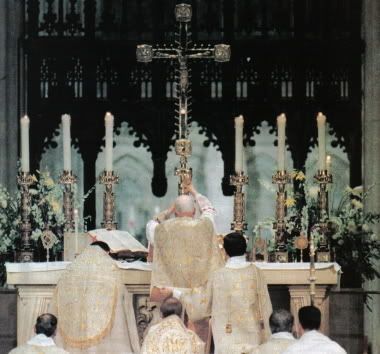
In celebration of the motu proprio Summurum Pontificum, here are a few pictures from the Solemn Pontifical Mass celebrated by Alfons Cardinal Stickler from the 1962 Missal on 12 May 1996 at St Patrick's Cathedral. It was the first time the high altar had been used and the first time the tridentine rite had been used there in a generation.
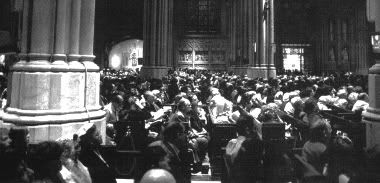
It was the Fifth Sunday of Easter, it was also 6pm on Mother's Day, and yet they came. Back in the sacristy, John Cardinal O'Conner remarked that he had never seen so many people fill the church, as preparations were underway to receive the visiting prefect emeritus of the Vatican Library. Over 5,000 people would fill the pews on that occasion, shocking the diocesan chancery and the local Catholic establishment.

Cardinal Stickler arrived by limousine and was escorted into the cathedral by Fr John Perricone of St Agnes' Church in Manhattan. Led by the local Knights of Columbus, the prelate processed into the church wearing the scarlet cappa magna with train and proceeded to a side altar where he was solemnly vested for the liturgy.
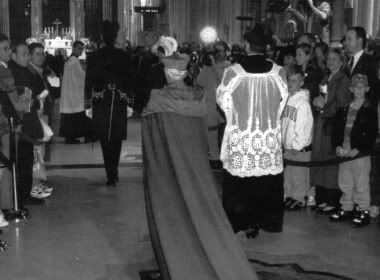
John Cardinal O'Conner, a friend of Stickler and the Archbishop of New York, gave a warm welcome to the assembled faithful. "I feel priveledged that you have requested this Mass be celebrated here in what is your cathedral," he told the crowd. "All are welcome here. We are one body, one body in Christ. It is imperative that you know how warmly and enthusiastically you are welcomed on this very special occasion."
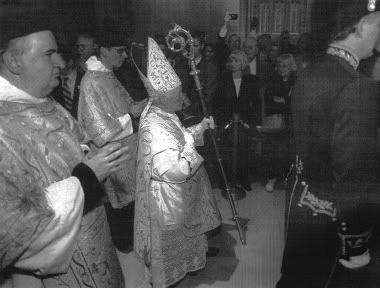
It was certainly counter-cultural, but it was not a protest. There were no dissidents. There were no complaints. It was a gathering of the faithful--young and old, children and adults, women and men, people from every race and nationality--to give thanks for their heritage and to celebrate their faith. And the best way to do that is with the solemn worship of Almighty God.

Photos from The Latin Mass Magazine.
Tuesday, July 10, 2007
Some cool downloads
I have come across some cool liturgical pdf downloads recently.
You can find a facsimile of the Anglican Missal here.
You can find a good clean pdf of the 1920 edition of the Missale Romanum here.
And there is a beautiful and very traditional instructional missal for children here. It can also be ordered in print.
You can find a facsimile of the Anglican Missal here.
You can find a good clean pdf of the 1920 edition of the Missale Romanum here.
And there is a beautiful and very traditional instructional missal for children here. It can also be ordered in print.
Monday, July 09, 2007
He sent them out "two by two"
One thing that we should not gloss over in Sunday's gospel (Luke 10:1-12,16-20) is that the Lord sent out the Seventy "two by two" for their missionary journey. Though never mentioned as an explicit policy in the New Testament, that practice continued as a part of the missionary structure of the early Church. Surely, it was intended by Christ to be a check on individualism and personal authority, to be authoritative and verifiable messengers of truth, to be a reminder of our common life and cooperative work, and to be a means of communion within the body of Christ. I have listed some examples below, but I am sure there are others.
Luke 10:1-2
After this the Lord appointed seventy others and sent them on ahead of him, two by two, into every town and place where he himself was about to go. And he said to them, "The harvest is plentiful, but the laborers are few. Therefore pray earnestly to the Lord of the harvest to send out laborers into his harvest."
Consider also, that Jesus called the first apostles in groups of two: Peter and Andrew (Mt 4:18), then he called James and John (Mt 4:21).
While he was in prison, John sent two of his disciples to inquire about Jesus (Mt 11:2).
Jesus said that when two are in agreement in prayer, their request will be granted (Mt 18:19) and when two are gathered in his name, he would be in their midst (Mt 18:20).
When they needed a donkey for Palm Sunday, Jesus sent out two disciples to obtain one (Mt 21:1).
Jesus sent the twelve out two by two on their missionary journey (Mk 6:7).
Under the direction of the Holy Ghost, the apostles sent Barnabas and Paul on the first great missionary journey of the early Church (Acts 13:2).
Judas Barsabbas and Silas were also sent together (Acts 15:27).
On the next mission trip, Barnabas went with Mark and Paul went with Silas (Acts 15:39-40).
To the Corinthians, Paul describes Titus as "my partner and fellow worker" (2 Cor 8:23).
Paul sent Timothy and Erastus to Macedonia (Acts 19:22).
Paul sent Tychicus and Onesimus to the Colossians (Col 4:7-9).
Luke 10:1-2
After this the Lord appointed seventy others and sent them on ahead of him, two by two, into every town and place where he himself was about to go. And he said to them, "The harvest is plentiful, but the laborers are few. Therefore pray earnestly to the Lord of the harvest to send out laborers into his harvest."
Consider also, that Jesus called the first apostles in groups of two: Peter and Andrew (Mt 4:18), then he called James and John (Mt 4:21).
While he was in prison, John sent two of his disciples to inquire about Jesus (Mt 11:2).
Jesus said that when two are in agreement in prayer, their request will be granted (Mt 18:19) and when two are gathered in his name, he would be in their midst (Mt 18:20).
When they needed a donkey for Palm Sunday, Jesus sent out two disciples to obtain one (Mt 21:1).
Jesus sent the twelve out two by two on their missionary journey (Mk 6:7).
Under the direction of the Holy Ghost, the apostles sent Barnabas and Paul on the first great missionary journey of the early Church (Acts 13:2).
Judas Barsabbas and Silas were also sent together (Acts 15:27).
On the next mission trip, Barnabas went with Mark and Paul went with Silas (Acts 15:39-40).
To the Corinthians, Paul describes Titus as "my partner and fellow worker" (2 Cor 8:23).
Paul sent Timothy and Erastus to Macedonia (Acts 19:22).
Paul sent Tychicus and Onesimus to the Colossians (Col 4:7-9).
Saturday, July 07, 2007
Summorum Pontificum

As many of you know, the pope has issued the long-awaited motu proprio "Summorum Pontificum" (Latin original here; English translation here) which will lift many of the former restrictions on the celebration of the classical version of the Roman liturgy which was in use prior to the Novus Ordo Missae promulgated by Pope Paul VI in 1969. The English translation of Benedict XVI's explanatory letter to bishops is here.
It is a glorious day for all who love the liturgy, a wonderful opportunity for a renewal of faith and devotion that all of us should endeavor to take advantage of. I am sure the blessings to the Latin church will spill over into the worship life of other churches as well. One thing that should get particular attention is the fact that the need for the liberalization of the older version of the rite has become more imperative because of the growing response of young generations to the classical rites. (Could the New Mass end up going the way of New Coke? If so, it won't happen right away; but over time, who knows?) Below, I have pulled some key quotes from the pope's explanatory letter.
It is not appropriate to speak of these two versions of the Roman Missal as if they were “two Rites”. Rather, it is a matter of a twofold use of one and the same rite.
. . . in many places celebrations were not faithful to the prescriptions of the new Missal, but the latter actually was understood as authorizing or even requiring creativity, which frequently led to deformations of the liturgy which were hard to bear. I am speaking from experience, since I too lived through that period with all its hopes and its confusion. And I have seen how arbitrary deformations of the liturgy caused deep pain to individuals totally rooted in the faith of the Church. . . .
Immediately after the Second Vatican Council it was presumed that requests for the use of the 1962 Missal would be limited to the older generation which had grown up with it, but in the meantime it has clearly been demonstrated that young persons too have discovered this liturgical form, felt its attraction and found in it a form of encounter with the Mystery of the Most Holy Eucharist, particularly suited to them. Thus the need has arisen for a clearer juridical regulation which had not been foreseen at the time of the 1988 Motu Proprio. The present Norms are also meant to free Bishops from constantly having to evaluate anew how they are to respond to various situations.
. . . the two Forms of the usage of the Roman Rite can be mutually enriching: new Saints and some of the new Prefaces can and should be inserted in the old Missal. . . . The celebration of the Mass according to the Missal of Paul VI will be able to demonstrate, more powerfully than has been the case hitherto, the sacrality which attracts many people to the former usage. The most sure guarantee that the Missal of Paul VI can unite parish communities and be loved by them consists in its being celebrated with great reverence in harmony with the liturgical directives. This will bring out the spiritual richness and the theological depth of this Missal.
. . . I now come to the positive reason which motivated my decision to issue this Motu Proprio updating that of 1988. It is a matter of coming to an interior reconciliation in the heart of the Church. Looking back over the past, to the divisions which in the course of the centuries have rent the Body of Christ, one continually has the impression that, at critical moments when divisions were coming about, not enough was done by the Church’s leaders to maintain or regain reconciliation and unity. One has the impression that omissions on the part of the Church have had their share of blame for the fact that these divisions were able to harden. This glance at the past imposes an obligation on us today: to make every effort to unable for all those who truly desire unity to remain in that unity or to attain it anew. . . . Let us generously open our hearts and make room for everything that the faith itself allows.
There is no contradiction between the two editions of the Roman Missal. In the history of the liturgy there is growth and progress, but no rupture. What earlier generations held as sacred, remains sacred and great for us too, and it cannot be all of a sudden entirely forbidden or even considered harmful. It behooves all of us to preserve the riches which have developed in the Church’s faith and prayer, and to give them their proper place.
It seems to me that the two versions of the Roman Rite not only can co-exist, but also will mutually enrich the celebration of the other. The common celebration of the older missal cannot but help bring some sense of normalcy and heritage to the spiritual life of the congregations using the newer missal. Likewise, in this shared life, the newer missal may over time help bring the enrichment and reform to the older missal which is closer to the reform which the Second Vatican Council envisioned in the first place.
Can the two missals co-exist in a parish the way "Rite One" and "Rite Two" (and the 1928 and 1979 BCPs) do in American Episcopal churches? I think it is both possible and doable. But it will take dedication, patience, and charity. Do not expect every experience to go well. Fr Phillips from Our Lady of the Atonement Church in San Antonio relates a bad experience with the 1962 missal in his own parish here. But he still thinks the development is still a good things overall and can work.
As the Holy Father noted: "It behooves all of us to preserve the riches which have developed in the Church’s faith and prayer, and to give them their proper place."
Thursday, July 05, 2007
Speaking out and keeping silent
In Chapter 4 of Book 2 of his Treatise on Pastoral Care, Pope St. Gregory the Great wrote:
That the Rector should be discreet in keeping silence, profitable in speech.
A spiritual guide should be silent when discretion requires and speak when words are of service. Otherwise you may say what you should not or be silent when you should speak. Indiscreet speech may lead people into error and an imprudent silence may leave in error those who could have been taught. Pastors who lack foresight hesitate to say openly what is right because they fear losing the favor of their people. As the voice of truth tells us (John 10:12), such leaders are not zealous pastors who protect their flocks, rather they are like mercenaries who flee by taking refuge in silence when the wolf appears.
The Lord reproaches them through the prophet: "They are dumb dogs that cannot bark." On another occasion he complains: "You did not advance against the foe or set up a wall in front of the house of Israel, so that you might stand fast in battle on the day of the Lord" (Ezekiel 8:5). To advance against the foe involves a bold resistance to the powers of this world in defense of the flock. To stand fast in battle on the day of the Lord means to oppose the wicked enemy out of love for what is right.
When a pastor has been afraid to assert what is right, has that shepherd not turned back and fled by remaining silent? Whereas if you intervene on behalf of the flock, you set up a wall against the enemy in front of the house of Israel. Therefore, the Lord again says to his unfaithful people: "Your prophets saw false and foolish visions and did not point out your wickedness, that you might repent of your sins" (Lamentations 2:14). The name of the prophet is sometimes given in the sacred writings to teachers who both declare the present to be fleeting and reveal what is to come. The word of God accuses them of seeing false visions because they are afraid to reproach people for their faults and thereby lull the evildoer with an empty promise of safety. Because they fear reproach, they keep silent and fail to point out the sinner's wrongdoing.
The word of reproach is a key that unlocks a door, because reproach reveals a fault of which the evildoer is often unaware. That is why Paul says: "A bishop must be able to encourage people in sound doctrine and refute those who oppose it" (Titus 1:9). For the same reason God tells us through Malachi: "The lips of the priest are to preserve knowledge, and people shall look to the priest for the law, for the priest is the messenger of the Lord of hosts" (Malachi 2:7). Finally, that is also the reason why the Lord warns us through Isaiah: "Cry out and be not still; raise your voice in a trumpet call."
All who are ordained priest undertake the task of preaching, so that with a loud cry they may go on ahead of the terrible judge who fellow's. If, then, a priest does not know how to preach, what kind of cry can such a dumb herald utter? It was to bring this home that the Holy Spirit descended in the form of tongues on the first pastors (Acts 2:3), for the Spirit causes those who are thus filled, to speak out spontaneously.
You can read the whole Liber Regulæ Pastoralis here.
That the Rector should be discreet in keeping silence, profitable in speech.
A spiritual guide should be silent when discretion requires and speak when words are of service. Otherwise you may say what you should not or be silent when you should speak. Indiscreet speech may lead people into error and an imprudent silence may leave in error those who could have been taught. Pastors who lack foresight hesitate to say openly what is right because they fear losing the favor of their people. As the voice of truth tells us (John 10:12), such leaders are not zealous pastors who protect their flocks, rather they are like mercenaries who flee by taking refuge in silence when the wolf appears.
The Lord reproaches them through the prophet: "They are dumb dogs that cannot bark." On another occasion he complains: "You did not advance against the foe or set up a wall in front of the house of Israel, so that you might stand fast in battle on the day of the Lord" (Ezekiel 8:5). To advance against the foe involves a bold resistance to the powers of this world in defense of the flock. To stand fast in battle on the day of the Lord means to oppose the wicked enemy out of love for what is right.
When a pastor has been afraid to assert what is right, has that shepherd not turned back and fled by remaining silent? Whereas if you intervene on behalf of the flock, you set up a wall against the enemy in front of the house of Israel. Therefore, the Lord again says to his unfaithful people: "Your prophets saw false and foolish visions and did not point out your wickedness, that you might repent of your sins" (Lamentations 2:14). The name of the prophet is sometimes given in the sacred writings to teachers who both declare the present to be fleeting and reveal what is to come. The word of God accuses them of seeing false visions because they are afraid to reproach people for their faults and thereby lull the evildoer with an empty promise of safety. Because they fear reproach, they keep silent and fail to point out the sinner's wrongdoing.
The word of reproach is a key that unlocks a door, because reproach reveals a fault of which the evildoer is often unaware. That is why Paul says: "A bishop must be able to encourage people in sound doctrine and refute those who oppose it" (Titus 1:9). For the same reason God tells us through Malachi: "The lips of the priest are to preserve knowledge, and people shall look to the priest for the law, for the priest is the messenger of the Lord of hosts" (Malachi 2:7). Finally, that is also the reason why the Lord warns us through Isaiah: "Cry out and be not still; raise your voice in a trumpet call."
All who are ordained priest undertake the task of preaching, so that with a loud cry they may go on ahead of the terrible judge who fellow's. If, then, a priest does not know how to preach, what kind of cry can such a dumb herald utter? It was to bring this home that the Holy Spirit descended in the form of tongues on the first pastors (Acts 2:3), for the Spirit causes those who are thus filled, to speak out spontaneously.
You can read the whole Liber Regulæ Pastoralis here.
Subscribe to:
Comments (Atom)

